Project Risk and Procurement Management for Reflektion: Sourcing Methods and Strategic Source Framework
VerifiedAdded on 2023/06/11
|20
|4537
|283
AI Summary
The study analyses project risk and procurement management for Reflektion, a software company in the USA. It determines different acceptable levels of risks and proposes a strategic source system for value growth and excellence of procurements. The report examines various methods of sourcing and supplier base for Reflektion and suggests a diplomatic source system. The strategic source framework is proposed to satisfy business requirements and incorporate values to business. The report also discusses the importance of procurement for global organisations.
Contribute Materials
Your contribution can guide someone’s learning journey. Share your
documents today.
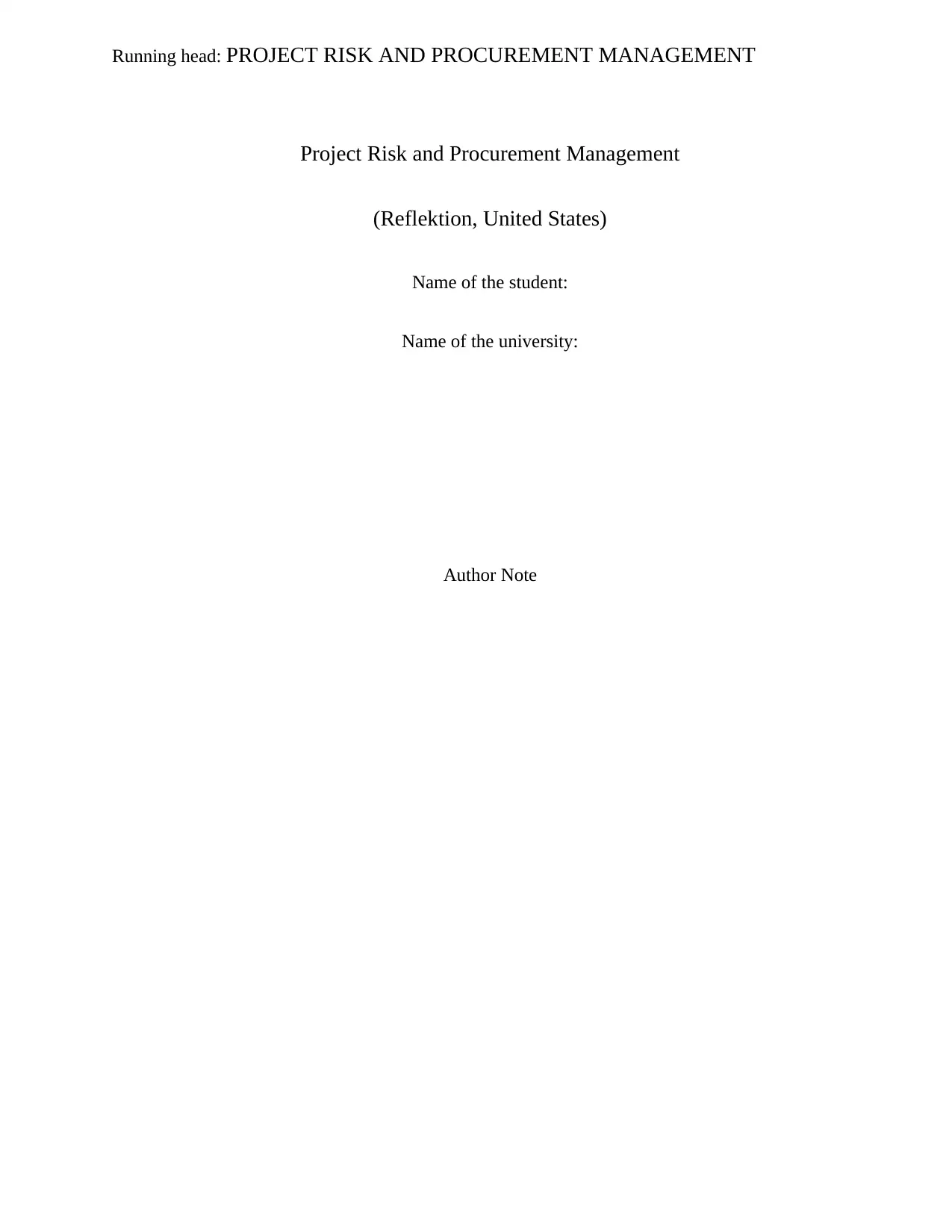
Running head: PROJECT RISK AND PROCUREMENT MANAGEMENT
Project Risk and Procurement Management
(Reflektion, United States)
Name of the student:
Name of the university:
Author Note
Project Risk and Procurement Management
(Reflektion, United States)
Name of the student:
Name of the university:
Author Note
Secure Best Marks with AI Grader
Need help grading? Try our AI Grader for instant feedback on your assignments.
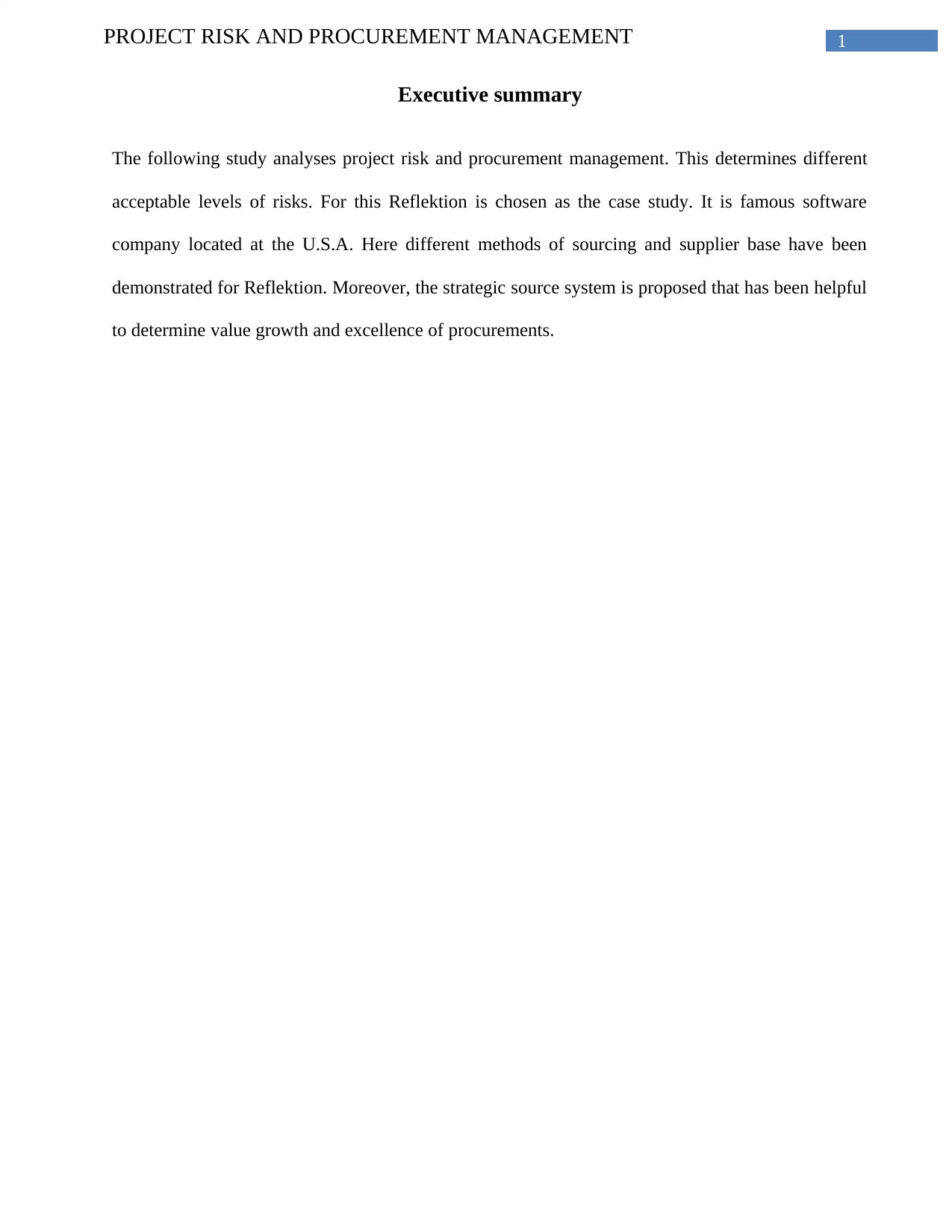
1PROJECT RISK AND PROCUREMENT MANAGEMENT
Executive summary
The following study analyses project risk and procurement management. This determines different
acceptable levels of risks. For this Reflektion is chosen as the case study. It is famous software
company located at the U.S.A. Here different methods of sourcing and supplier base have been
demonstrated for Reflektion. Moreover, the strategic source system is proposed that has been helpful
to determine value growth and excellence of procurements.
Executive summary
The following study analyses project risk and procurement management. This determines different
acceptable levels of risks. For this Reflektion is chosen as the case study. It is famous software
company located at the U.S.A. Here different methods of sourcing and supplier base have been
demonstrated for Reflektion. Moreover, the strategic source system is proposed that has been helpful
to determine value growth and excellence of procurements.
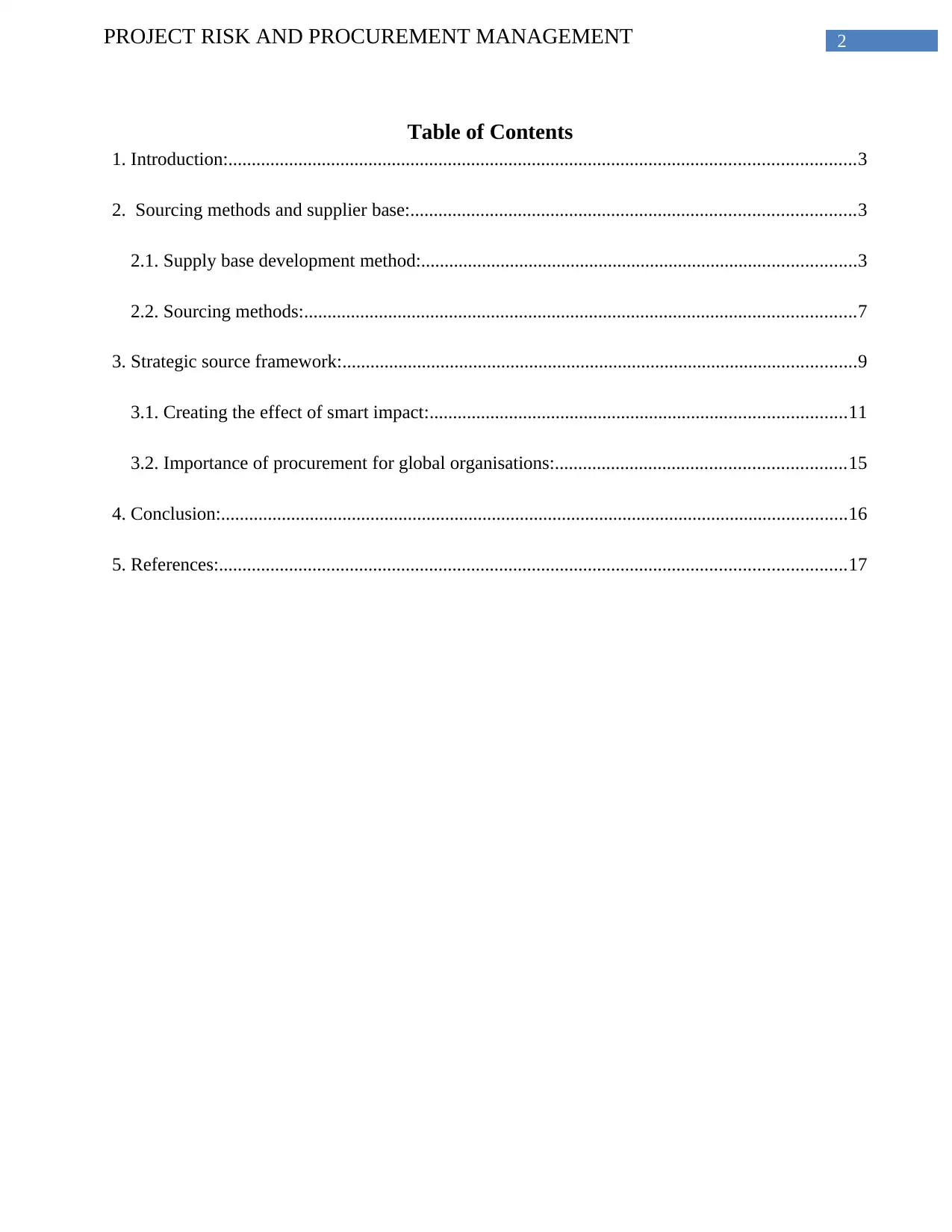
2PROJECT RISK AND PROCUREMENT MANAGEMENT
Table of Contents
1. Introduction:......................................................................................................................................3
2. Sourcing methods and supplier base:...............................................................................................3
2.1. Supply base development method:.............................................................................................3
2.2. Sourcing methods:......................................................................................................................7
3. Strategic source framework:..............................................................................................................9
3.1. Creating the effect of smart impact:.........................................................................................11
3.2. Importance of procurement for global organisations:..............................................................15
4. Conclusion:......................................................................................................................................16
5. References:......................................................................................................................................17
Table of Contents
1. Introduction:......................................................................................................................................3
2. Sourcing methods and supplier base:...............................................................................................3
2.1. Supply base development method:.............................................................................................3
2.2. Sourcing methods:......................................................................................................................7
3. Strategic source framework:..............................................................................................................9
3.1. Creating the effect of smart impact:.........................................................................................11
3.2. Importance of procurement for global organisations:..............................................................15
4. Conclusion:......................................................................................................................................16
5. References:......................................................................................................................................17
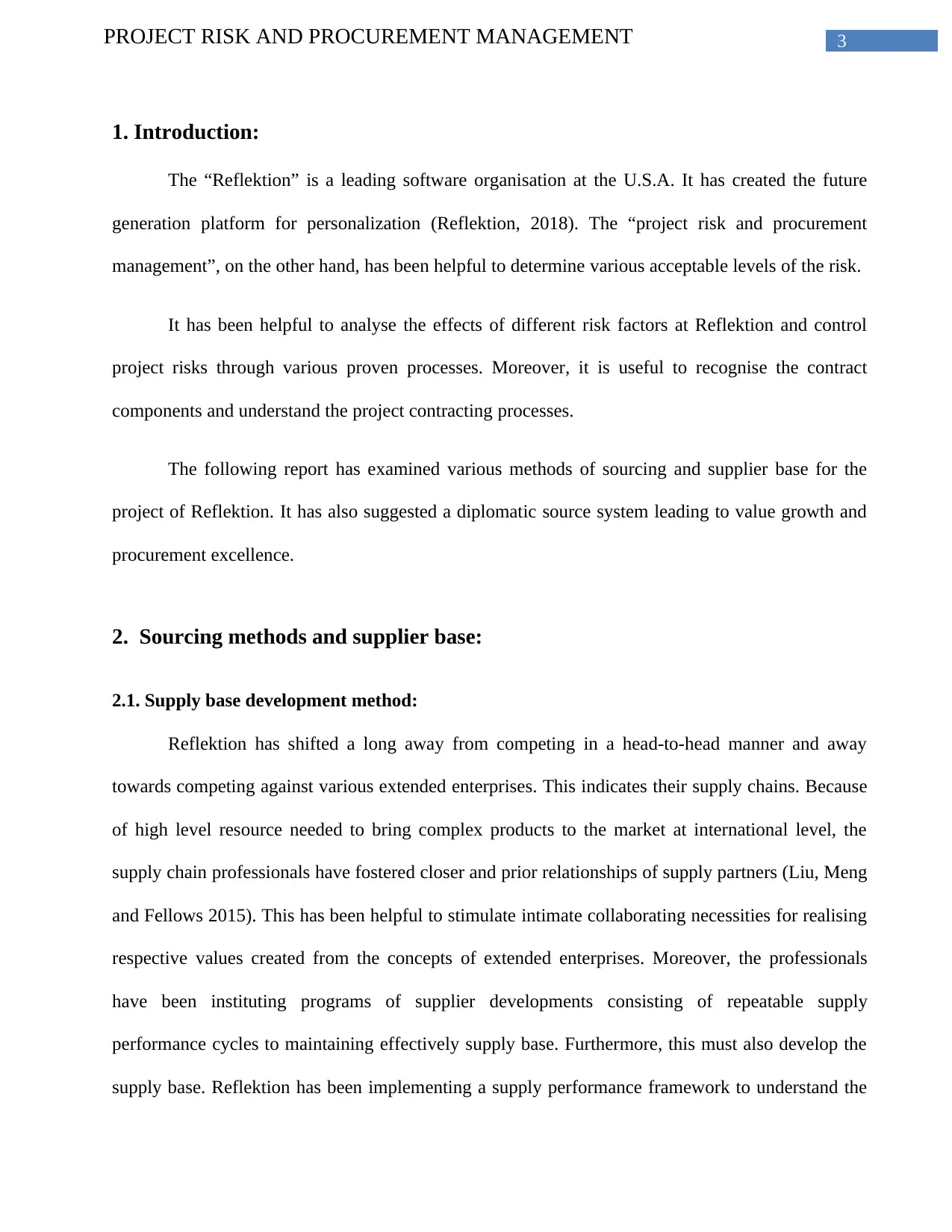
3PROJECT RISK AND PROCUREMENT MANAGEMENT
1. Introduction:
The “Reflektion” is a leading software organisation at the U.S.A. It has created the future
generation platform for personalization (Reflektion, 2018). The “project risk and procurement
management”, on the other hand, has been helpful to determine various acceptable levels of the risk.
It has been helpful to analyse the effects of different risk factors at Reflektion and control
project risks through various proven processes. Moreover, it is useful to recognise the contract
components and understand the project contracting processes.
The following report has examined various methods of sourcing and supplier base for the
project of Reflektion. It has also suggested a diplomatic source system leading to value growth and
procurement excellence.
2. Sourcing methods and supplier base:
2.1. Supply base development method:
Reflektion has shifted a long away from competing in a head-to-head manner and away
towards competing against various extended enterprises. This indicates their supply chains. Because
of high level resource needed to bring complex products to the market at international level, the
supply chain professionals have fostered closer and prior relationships of supply partners (Liu, Meng
and Fellows 2015). This has been helpful to stimulate intimate collaborating necessities for realising
respective values created from the concepts of extended enterprises. Moreover, the professionals
have been instituting programs of supplier developments consisting of repeatable supply
performance cycles to maintaining effectively supply base. Furthermore, this must also develop the
supply base. Reflektion has been implementing a supply performance framework to understand the
1. Introduction:
The “Reflektion” is a leading software organisation at the U.S.A. It has created the future
generation platform for personalization (Reflektion, 2018). The “project risk and procurement
management”, on the other hand, has been helpful to determine various acceptable levels of the risk.
It has been helpful to analyse the effects of different risk factors at Reflektion and control
project risks through various proven processes. Moreover, it is useful to recognise the contract
components and understand the project contracting processes.
The following report has examined various methods of sourcing and supplier base for the
project of Reflektion. It has also suggested a diplomatic source system leading to value growth and
procurement excellence.
2. Sourcing methods and supplier base:
2.1. Supply base development method:
Reflektion has shifted a long away from competing in a head-to-head manner and away
towards competing against various extended enterprises. This indicates their supply chains. Because
of high level resource needed to bring complex products to the market at international level, the
supply chain professionals have fostered closer and prior relationships of supply partners (Liu, Meng
and Fellows 2015). This has been helpful to stimulate intimate collaborating necessities for realising
respective values created from the concepts of extended enterprises. Moreover, the professionals
have been instituting programs of supplier developments consisting of repeatable supply
performance cycles to maintaining effectively supply base. Furthermore, this must also develop the
supply base. Reflektion has been implementing a supply performance framework to understand the
Secure Best Marks with AI Grader
Need help grading? Try our AI Grader for instant feedback on your assignments.
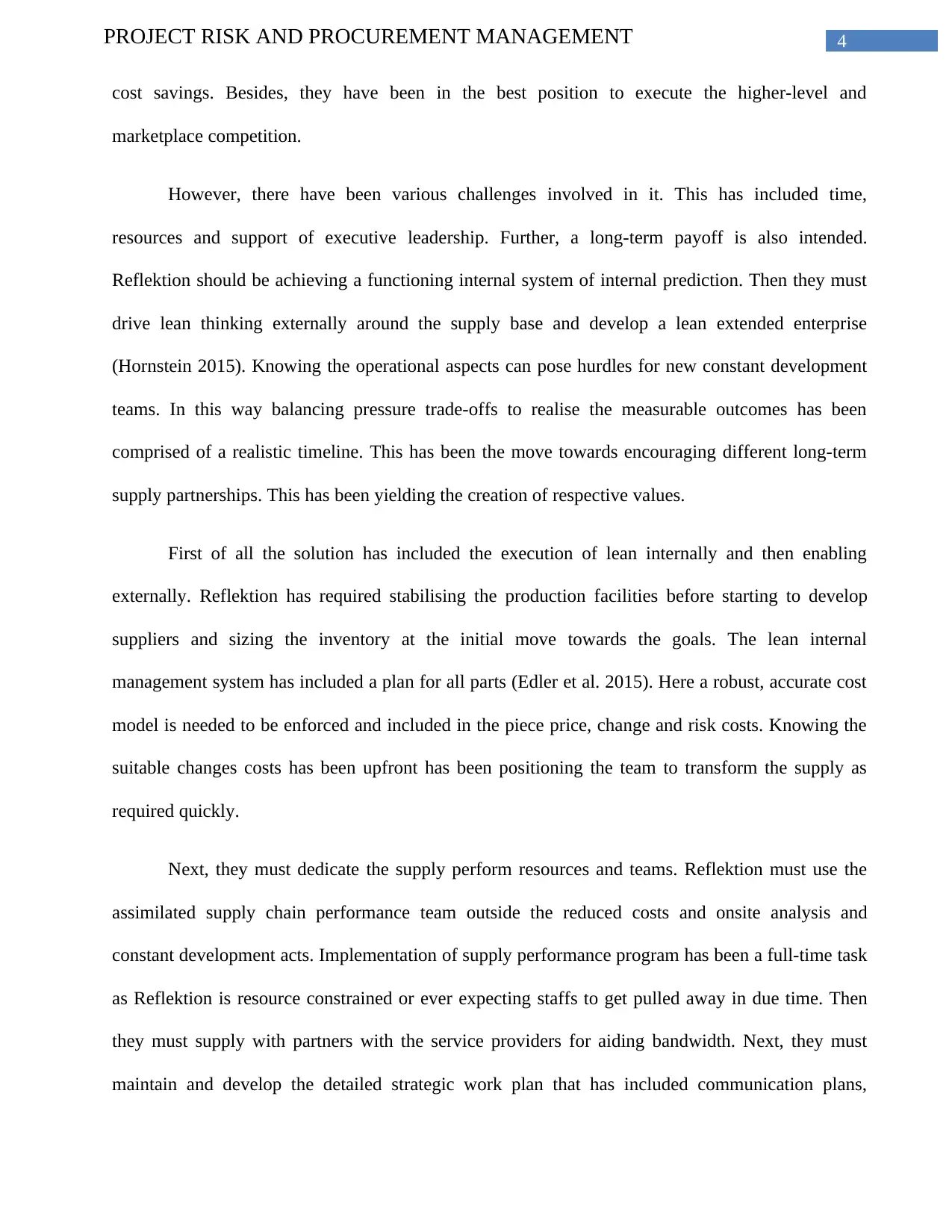
4PROJECT RISK AND PROCUREMENT MANAGEMENT
cost savings. Besides, they have been in the best position to execute the higher-level and
marketplace competition.
However, there have been various challenges involved in it. This has included time,
resources and support of executive leadership. Further, a long-term payoff is also intended.
Reflektion should be achieving a functioning internal system of internal prediction. Then they must
drive lean thinking externally around the supply base and develop a lean extended enterprise
(Hornstein 2015). Knowing the operational aspects can pose hurdles for new constant development
teams. In this way balancing pressure trade-offs to realise the measurable outcomes has been
comprised of a realistic timeline. This has been the move towards encouraging different long-term
supply partnerships. This has been yielding the creation of respective values.
First of all the solution has included the execution of lean internally and then enabling
externally. Reflektion has required stabilising the production facilities before starting to develop
suppliers and sizing the inventory at the initial move towards the goals. The lean internal
management system has included a plan for all parts (Edler et al. 2015). Here a robust, accurate cost
model is needed to be enforced and included in the piece price, change and risk costs. Knowing the
suitable changes costs has been upfront has been positioning the team to transform the supply as
required quickly.
Next, they must dedicate the supply perform resources and teams. Reflektion must use the
assimilated supply chain performance team outside the reduced costs and onsite analysis and
constant development acts. Implementation of supply performance program has been a full-time task
as Reflektion is resource constrained or ever expecting staffs to get pulled away in due time. Then
they must supply with partners with the service providers for aiding bandwidth. Next, they must
maintain and develop the detailed strategic work plan that has included communication plans,
cost savings. Besides, they have been in the best position to execute the higher-level and
marketplace competition.
However, there have been various challenges involved in it. This has included time,
resources and support of executive leadership. Further, a long-term payoff is also intended.
Reflektion should be achieving a functioning internal system of internal prediction. Then they must
drive lean thinking externally around the supply base and develop a lean extended enterprise
(Hornstein 2015). Knowing the operational aspects can pose hurdles for new constant development
teams. In this way balancing pressure trade-offs to realise the measurable outcomes has been
comprised of a realistic timeline. This has been the move towards encouraging different long-term
supply partnerships. This has been yielding the creation of respective values.
First of all the solution has included the execution of lean internally and then enabling
externally. Reflektion has required stabilising the production facilities before starting to develop
suppliers and sizing the inventory at the initial move towards the goals. The lean internal
management system has included a plan for all parts (Edler et al. 2015). Here a robust, accurate cost
model is needed to be enforced and included in the piece price, change and risk costs. Knowing the
suitable changes costs has been upfront has been positioning the team to transform the supply as
required quickly.
Next, they must dedicate the supply perform resources and teams. Reflektion must use the
assimilated supply chain performance team outside the reduced costs and onsite analysis and
constant development acts. Implementation of supply performance program has been a full-time task
as Reflektion is resource constrained or ever expecting staffs to get pulled away in due time. Then
they must supply with partners with the service providers for aiding bandwidth. Next, they must
maintain and develop the detailed strategic work plan that has included communication plans,
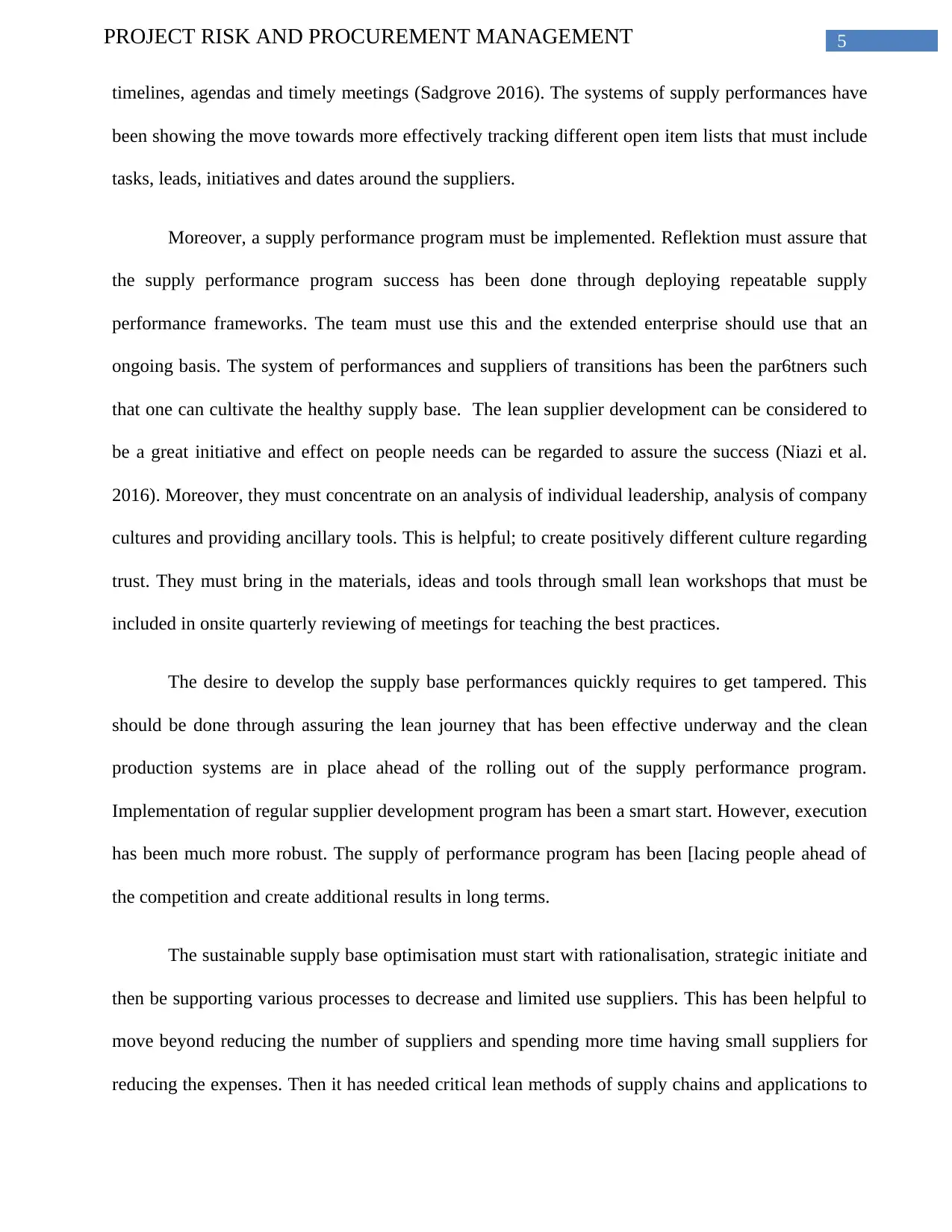
5PROJECT RISK AND PROCUREMENT MANAGEMENT
timelines, agendas and timely meetings (Sadgrove 2016). The systems of supply performances have
been showing the move towards more effectively tracking different open item lists that must include
tasks, leads, initiatives and dates around the suppliers.
Moreover, a supply performance program must be implemented. Reflektion must assure that
the supply performance program success has been done through deploying repeatable supply
performance frameworks. The team must use this and the extended enterprise should use that an
ongoing basis. The system of performances and suppliers of transitions has been the par6tners such
that one can cultivate the healthy supply base. The lean supplier development can be considered to
be a great initiative and effect on people needs can be regarded to assure the success (Niazi et al.
2016). Moreover, they must concentrate on an analysis of individual leadership, analysis of company
cultures and providing ancillary tools. This is helpful; to create positively different culture regarding
trust. They must bring in the materials, ideas and tools through small lean workshops that must be
included in onsite quarterly reviewing of meetings for teaching the best practices.
The desire to develop the supply base performances quickly requires to get tampered. This
should be done through assuring the lean journey that has been effective underway and the clean
production systems are in place ahead of the rolling out of the supply performance program.
Implementation of regular supplier development program has been a smart start. However, execution
has been much more robust. The supply of performance program has been [lacing people ahead of
the competition and create additional results in long terms.
The sustainable supply base optimisation must start with rationalisation, strategic initiate and
then be supporting various processes to decrease and limited use suppliers. This has been helpful to
move beyond reducing the number of suppliers and spending more time having small suppliers for
reducing the expenses. Then it has needed critical lean methods of supply chains and applications to
timelines, agendas and timely meetings (Sadgrove 2016). The systems of supply performances have
been showing the move towards more effectively tracking different open item lists that must include
tasks, leads, initiatives and dates around the suppliers.
Moreover, a supply performance program must be implemented. Reflektion must assure that
the supply performance program success has been done through deploying repeatable supply
performance frameworks. The team must use this and the extended enterprise should use that an
ongoing basis. The system of performances and suppliers of transitions has been the par6tners such
that one can cultivate the healthy supply base. The lean supplier development can be considered to
be a great initiative and effect on people needs can be regarded to assure the success (Niazi et al.
2016). Moreover, they must concentrate on an analysis of individual leadership, analysis of company
cultures and providing ancillary tools. This is helpful; to create positively different culture regarding
trust. They must bring in the materials, ideas and tools through small lean workshops that must be
included in onsite quarterly reviewing of meetings for teaching the best practices.
The desire to develop the supply base performances quickly requires to get tampered. This
should be done through assuring the lean journey that has been effective underway and the clean
production systems are in place ahead of the rolling out of the supply performance program.
Implementation of regular supplier development program has been a smart start. However, execution
has been much more robust. The supply of performance program has been [lacing people ahead of
the competition and create additional results in long terms.
The sustainable supply base optimisation must start with rationalisation, strategic initiate and
then be supporting various processes to decrease and limited use suppliers. This has been helpful to
move beyond reducing the number of suppliers and spending more time having small suppliers for
reducing the expenses. Then it has needed critical lean methods of supply chains and applications to
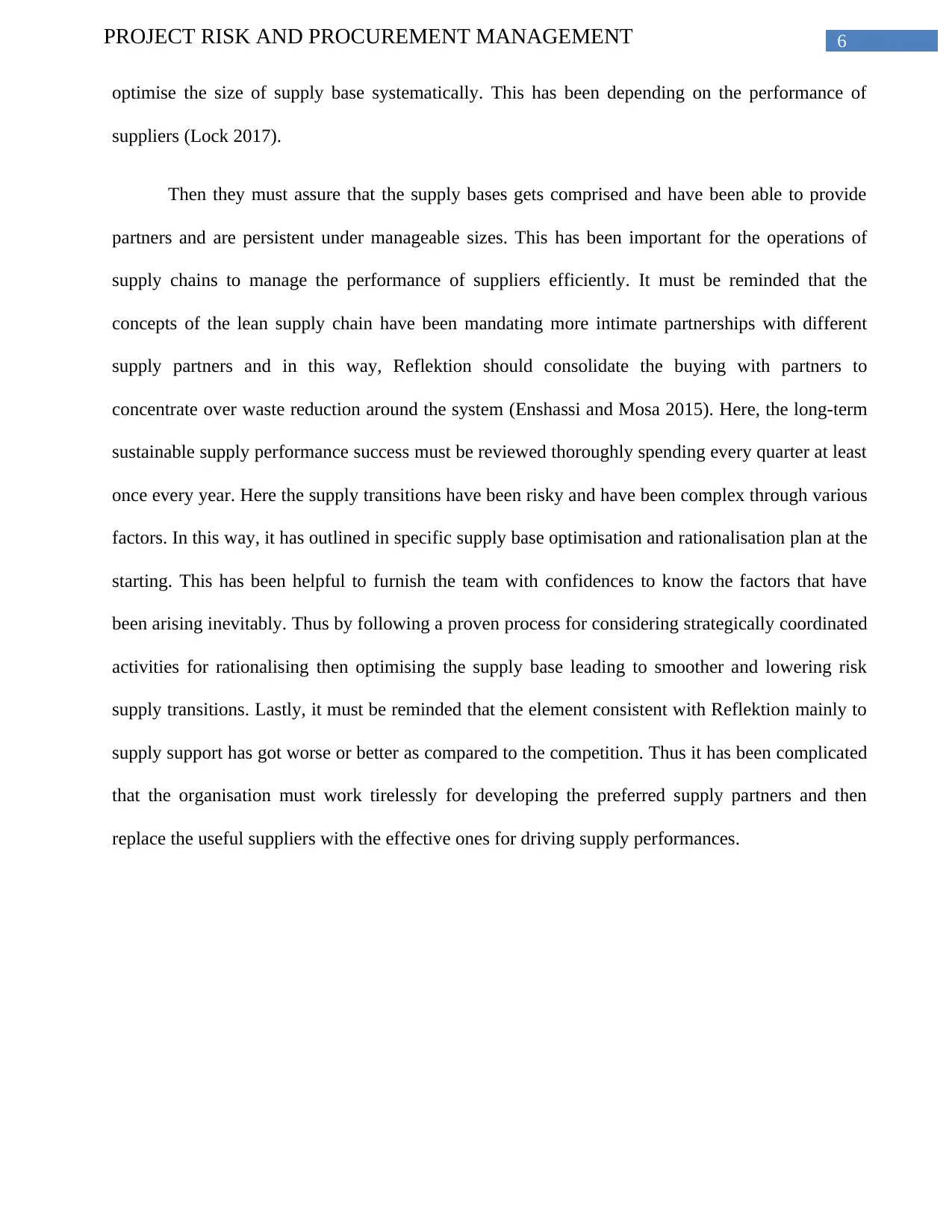
6PROJECT RISK AND PROCUREMENT MANAGEMENT
optimise the size of supply base systematically. This has been depending on the performance of
suppliers (Lock 2017).
Then they must assure that the supply bases gets comprised and have been able to provide
partners and are persistent under manageable sizes. This has been important for the operations of
supply chains to manage the performance of suppliers efficiently. It must be reminded that the
concepts of the lean supply chain have been mandating more intimate partnerships with different
supply partners and in this way, Reflektion should consolidate the buying with partners to
concentrate over waste reduction around the system (Enshassi and Mosa 2015). Here, the long-term
sustainable supply performance success must be reviewed thoroughly spending every quarter at least
once every year. Here the supply transitions have been risky and have been complex through various
factors. In this way, it has outlined in specific supply base optimisation and rationalisation plan at the
starting. This has been helpful to furnish the team with confidences to know the factors that have
been arising inevitably. Thus by following a proven process for considering strategically coordinated
activities for rationalising then optimising the supply base leading to smoother and lowering risk
supply transitions. Lastly, it must be reminded that the element consistent with Reflektion mainly to
supply support has got worse or better as compared to the competition. Thus it has been complicated
that the organisation must work tirelessly for developing the preferred supply partners and then
replace the useful suppliers with the effective ones for driving supply performances.
optimise the size of supply base systematically. This has been depending on the performance of
suppliers (Lock 2017).
Then they must assure that the supply bases gets comprised and have been able to provide
partners and are persistent under manageable sizes. This has been important for the operations of
supply chains to manage the performance of suppliers efficiently. It must be reminded that the
concepts of the lean supply chain have been mandating more intimate partnerships with different
supply partners and in this way, Reflektion should consolidate the buying with partners to
concentrate over waste reduction around the system (Enshassi and Mosa 2015). Here, the long-term
sustainable supply performance success must be reviewed thoroughly spending every quarter at least
once every year. Here the supply transitions have been risky and have been complex through various
factors. In this way, it has outlined in specific supply base optimisation and rationalisation plan at the
starting. This has been helpful to furnish the team with confidences to know the factors that have
been arising inevitably. Thus by following a proven process for considering strategically coordinated
activities for rationalising then optimising the supply base leading to smoother and lowering risk
supply transitions. Lastly, it must be reminded that the element consistent with Reflektion mainly to
supply support has got worse or better as compared to the competition. Thus it has been complicated
that the organisation must work tirelessly for developing the preferred supply partners and then
replace the useful suppliers with the effective ones for driving supply performances.
Paraphrase This Document
Need a fresh take? Get an instant paraphrase of this document with our AI Paraphraser
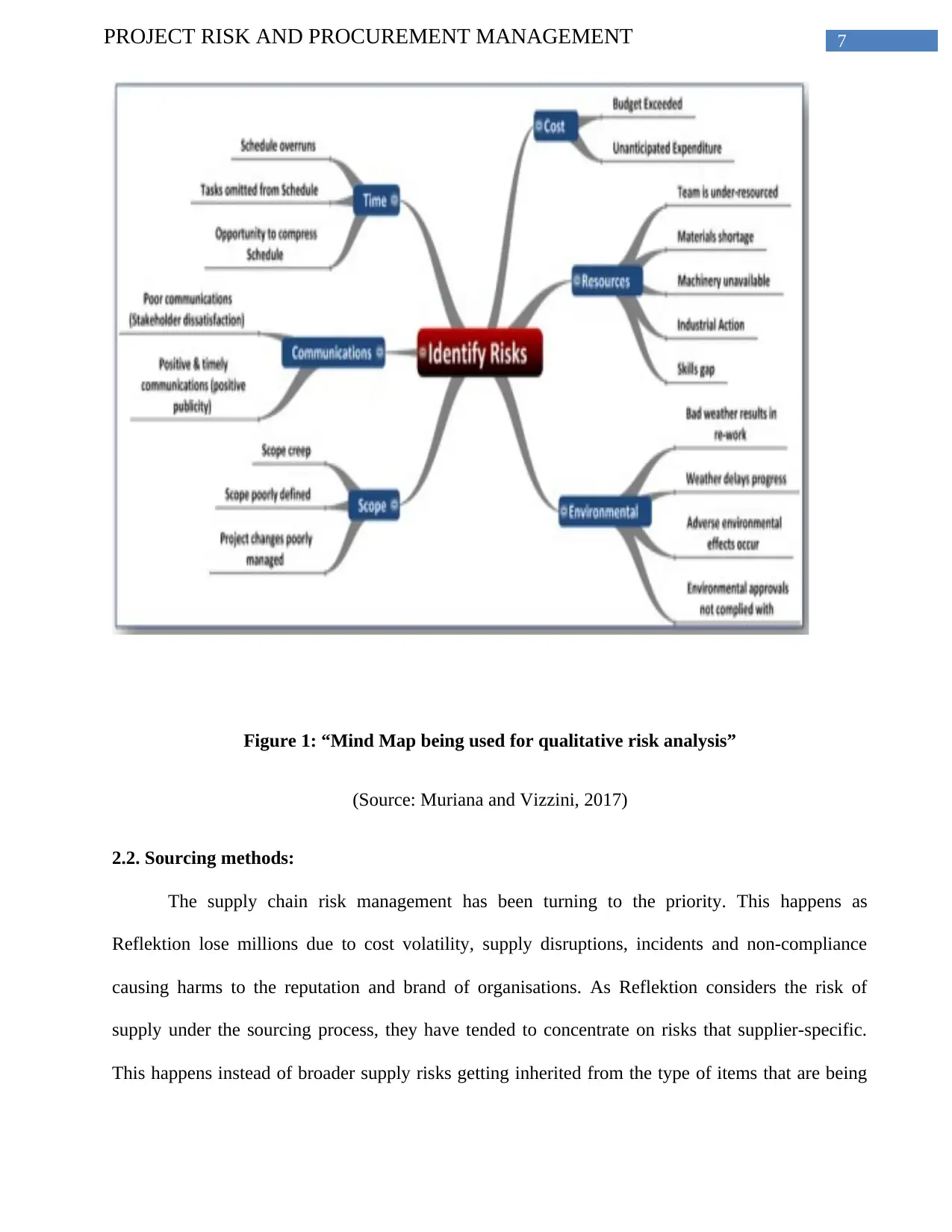
7PROJECT RISK AND PROCUREMENT MANAGEMENT
Figure 1: “Mind Map being used for qualitative risk analysis”
(Source: Muriana and Vizzini, 2017)
2.2. Sourcing methods:
The supply chain risk management has been turning to the priority. This happens as
Reflektion lose millions due to cost volatility, supply disruptions, incidents and non-compliance
causing harms to the reputation and brand of organisations. As Reflektion considers the risk of
supply under the sourcing process, they have tended to concentrate on risks that supplier-specific.
This happens instead of broader supply risks getting inherited from the type of items that are being
Figure 1: “Mind Map being used for qualitative risk analysis”
(Source: Muriana and Vizzini, 2017)
2.2. Sourcing methods:
The supply chain risk management has been turning to the priority. This happens as
Reflektion lose millions due to cost volatility, supply disruptions, incidents and non-compliance
causing harms to the reputation and brand of organisations. As Reflektion considers the risk of
supply under the sourcing process, they have tended to concentrate on risks that supplier-specific.
This happens instead of broader supply risks getting inherited from the type of items that are being
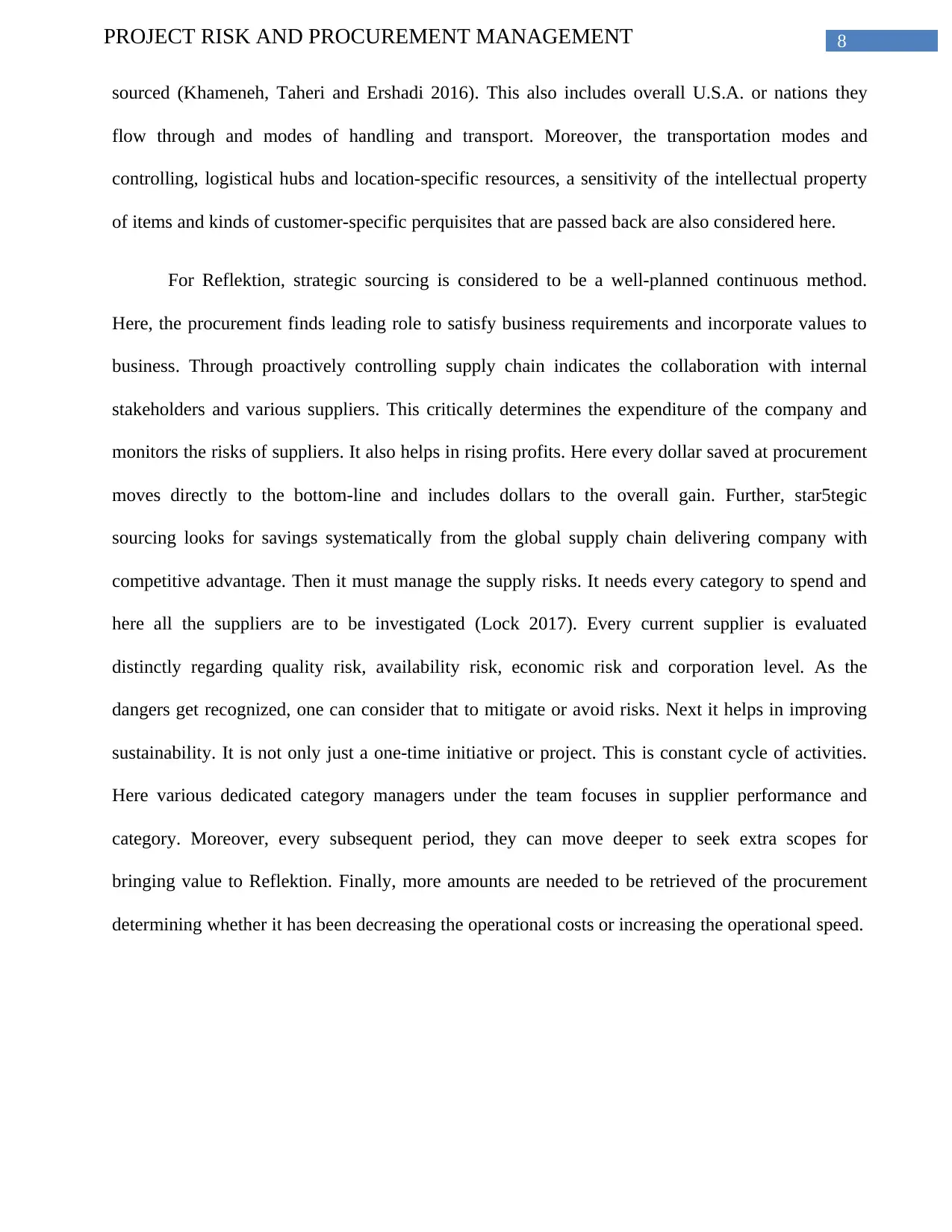
8PROJECT RISK AND PROCUREMENT MANAGEMENT
sourced (Khameneh, Taheri and Ershadi 2016). This also includes overall U.S.A. or nations they
flow through and modes of handling and transport. Moreover, the transportation modes and
controlling, logistical hubs and location-specific resources, a sensitivity of the intellectual property
of items and kinds of customer-specific perquisites that are passed back are also considered here.
For Reflektion, strategic sourcing is considered to be a well-planned continuous method.
Here, the procurement finds leading role to satisfy business requirements and incorporate values to
business. Through proactively controlling supply chain indicates the collaboration with internal
stakeholders and various suppliers. This critically determines the expenditure of the company and
monitors the risks of suppliers. It also helps in rising profits. Here every dollar saved at procurement
moves directly to the bottom-line and includes dollars to the overall gain. Further, star5tegic
sourcing looks for savings systematically from the global supply chain delivering company with
competitive advantage. Then it must manage the supply risks. It needs every category to spend and
here all the suppliers are to be investigated (Lock 2017). Every current supplier is evaluated
distinctly regarding quality risk, availability risk, economic risk and corporation level. As the
dangers get recognized, one can consider that to mitigate or avoid risks. Next it helps in improving
sustainability. It is not only just a one-time initiative or project. This is constant cycle of activities.
Here various dedicated category managers under the team focuses in supplier performance and
category. Moreover, every subsequent period, they can move deeper to seek extra scopes for
bringing value to Reflektion. Finally, more amounts are needed to be retrieved of the procurement
determining whether it has been decreasing the operational costs or increasing the operational speed.
sourced (Khameneh, Taheri and Ershadi 2016). This also includes overall U.S.A. or nations they
flow through and modes of handling and transport. Moreover, the transportation modes and
controlling, logistical hubs and location-specific resources, a sensitivity of the intellectual property
of items and kinds of customer-specific perquisites that are passed back are also considered here.
For Reflektion, strategic sourcing is considered to be a well-planned continuous method.
Here, the procurement finds leading role to satisfy business requirements and incorporate values to
business. Through proactively controlling supply chain indicates the collaboration with internal
stakeholders and various suppliers. This critically determines the expenditure of the company and
monitors the risks of suppliers. It also helps in rising profits. Here every dollar saved at procurement
moves directly to the bottom-line and includes dollars to the overall gain. Further, star5tegic
sourcing looks for savings systematically from the global supply chain delivering company with
competitive advantage. Then it must manage the supply risks. It needs every category to spend and
here all the suppliers are to be investigated (Lock 2017). Every current supplier is evaluated
distinctly regarding quality risk, availability risk, economic risk and corporation level. As the
dangers get recognized, one can consider that to mitigate or avoid risks. Next it helps in improving
sustainability. It is not only just a one-time initiative or project. This is constant cycle of activities.
Here various dedicated category managers under the team focuses in supplier performance and
category. Moreover, every subsequent period, they can move deeper to seek extra scopes for
bringing value to Reflektion. Finally, more amounts are needed to be retrieved of the procurement
determining whether it has been decreasing the operational costs or increasing the operational speed.
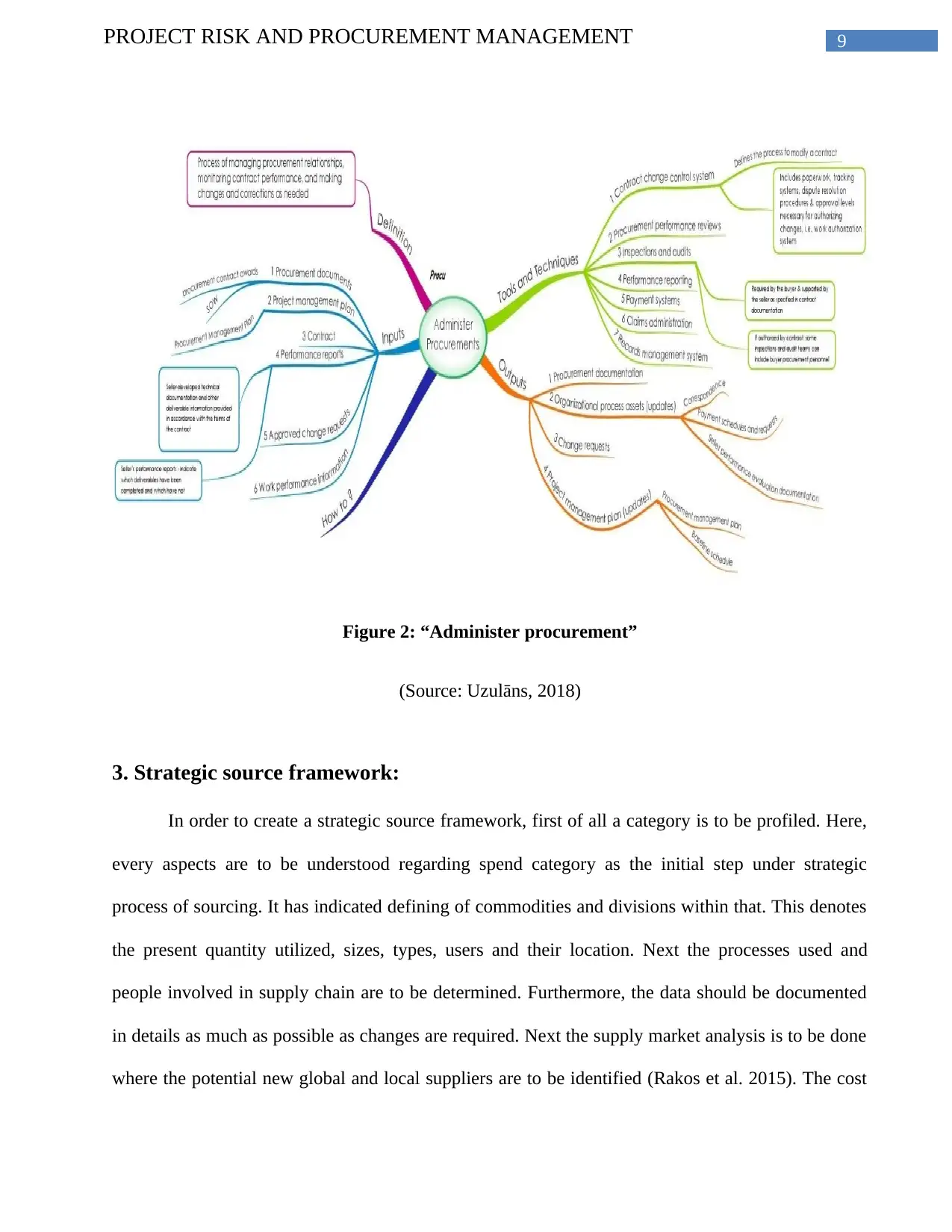
9PROJECT RISK AND PROCUREMENT MANAGEMENT
Figure 2: “Administer procurement”
(Source: Uzulāns, 2018)
3. Strategic source framework:
In order to create a strategic source framework, first of all a category is to be profiled. Here,
every aspects are to be understood regarding spend category as the initial step under strategic
process of sourcing. It has indicated defining of commodities and divisions within that. This denotes
the present quantity utilized, sizes, types, users and their location. Next the processes used and
people involved in supply chain are to be determined. Furthermore, the data should be documented
in details as much as possible as changes are required. Next the supply market analysis is to be done
where the potential new global and local suppliers are to be identified (Rakos et al. 2015). The cost
Figure 2: “Administer procurement”
(Source: Uzulāns, 2018)
3. Strategic source framework:
In order to create a strategic source framework, first of all a category is to be profiled. Here,
every aspects are to be understood regarding spend category as the initial step under strategic
process of sourcing. It has indicated defining of commodities and divisions within that. This denotes
the present quantity utilized, sizes, types, users and their location. Next the processes used and
people involved in supply chain are to be determined. Furthermore, the data should be documented
in details as much as possible as changes are required. Next the supply market analysis is to be done
where the potential new global and local suppliers are to be identified (Rakos et al. 2015). The cost
Secure Best Marks with AI Grader
Need help grading? Try our AI Grader for instant feedback on your assignments.
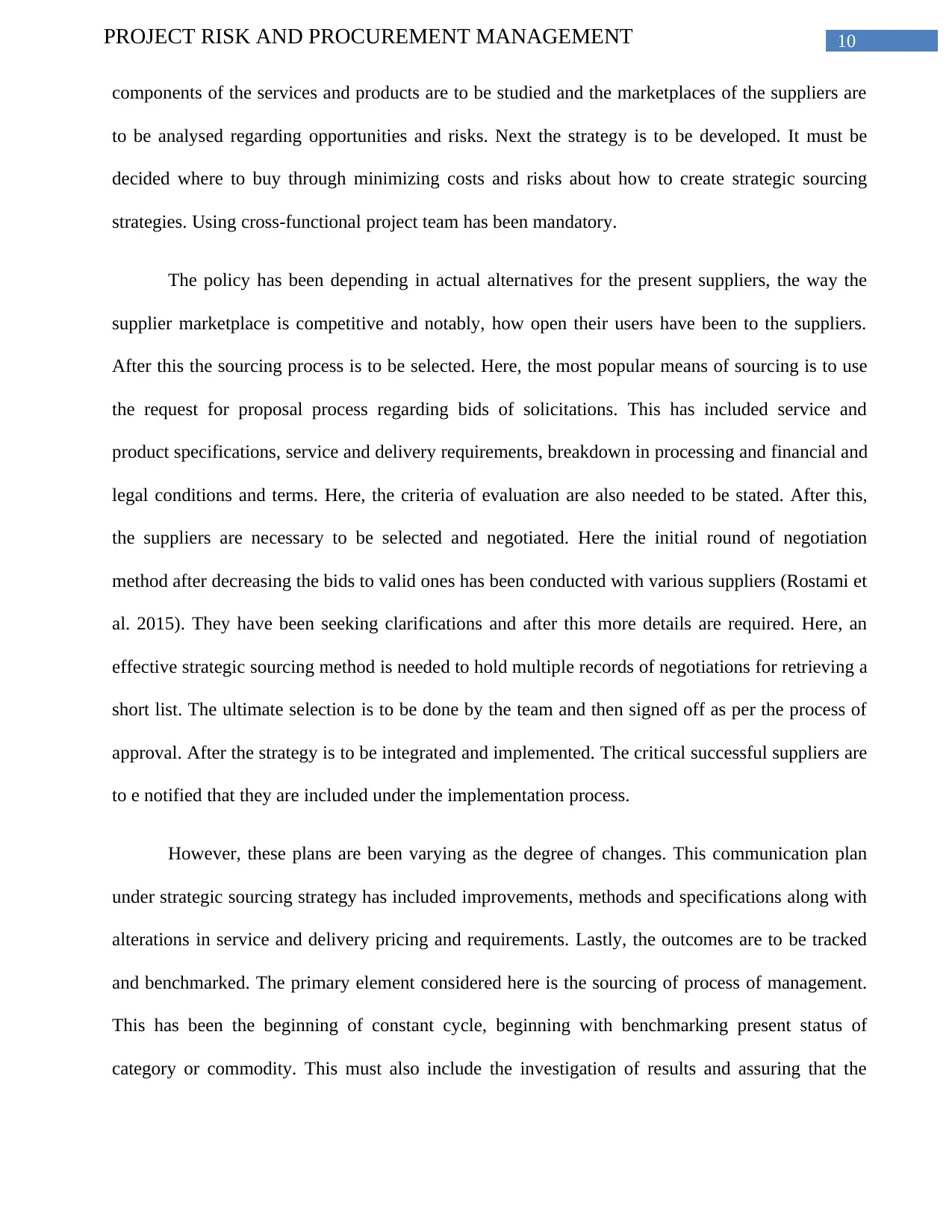
10PROJECT RISK AND PROCUREMENT MANAGEMENT
components of the services and products are to be studied and the marketplaces of the suppliers are
to be analysed regarding opportunities and risks. Next the strategy is to be developed. It must be
decided where to buy through minimizing costs and risks about how to create strategic sourcing
strategies. Using cross-functional project team has been mandatory.
The policy has been depending in actual alternatives for the present suppliers, the way the
supplier marketplace is competitive and notably, how open their users have been to the suppliers.
After this the sourcing process is to be selected. Here, the most popular means of sourcing is to use
the request for proposal process regarding bids of solicitations. This has included service and
product specifications, service and delivery requirements, breakdown in processing and financial and
legal conditions and terms. Here, the criteria of evaluation are also needed to be stated. After this,
the suppliers are necessary to be selected and negotiated. Here the initial round of negotiation
method after decreasing the bids to valid ones has been conducted with various suppliers (Rostami et
al. 2015). They have been seeking clarifications and after this more details are required. Here, an
effective strategic sourcing method is needed to hold multiple records of negotiations for retrieving a
short list. The ultimate selection is to be done by the team and then signed off as per the process of
approval. After the strategy is to be integrated and implemented. The critical successful suppliers are
to e notified that they are included under the implementation process.
However, these plans are been varying as the degree of changes. This communication plan
under strategic sourcing strategy has included improvements, methods and specifications along with
alterations in service and delivery pricing and requirements. Lastly, the outcomes are to be tracked
and benchmarked. The primary element considered here is the sourcing of process of management.
This has been the beginning of constant cycle, beginning with benchmarking present status of
category or commodity. This must also include the investigation of results and assuring that the
components of the services and products are to be studied and the marketplaces of the suppliers are
to be analysed regarding opportunities and risks. Next the strategy is to be developed. It must be
decided where to buy through minimizing costs and risks about how to create strategic sourcing
strategies. Using cross-functional project team has been mandatory.
The policy has been depending in actual alternatives for the present suppliers, the way the
supplier marketplace is competitive and notably, how open their users have been to the suppliers.
After this the sourcing process is to be selected. Here, the most popular means of sourcing is to use
the request for proposal process regarding bids of solicitations. This has included service and
product specifications, service and delivery requirements, breakdown in processing and financial and
legal conditions and terms. Here, the criteria of evaluation are also needed to be stated. After this,
the suppliers are necessary to be selected and negotiated. Here the initial round of negotiation
method after decreasing the bids to valid ones has been conducted with various suppliers (Rostami et
al. 2015). They have been seeking clarifications and after this more details are required. Here, an
effective strategic sourcing method is needed to hold multiple records of negotiations for retrieving a
short list. The ultimate selection is to be done by the team and then signed off as per the process of
approval. After the strategy is to be integrated and implemented. The critical successful suppliers are
to e notified that they are included under the implementation process.
However, these plans are been varying as the degree of changes. This communication plan
under strategic sourcing strategy has included improvements, methods and specifications along with
alterations in service and delivery pricing and requirements. Lastly, the outcomes are to be tracked
and benchmarked. The primary element considered here is the sourcing of process of management.
This has been the beginning of constant cycle, beginning with benchmarking present status of
category or commodity. This must also include the investigation of results and assuring that the
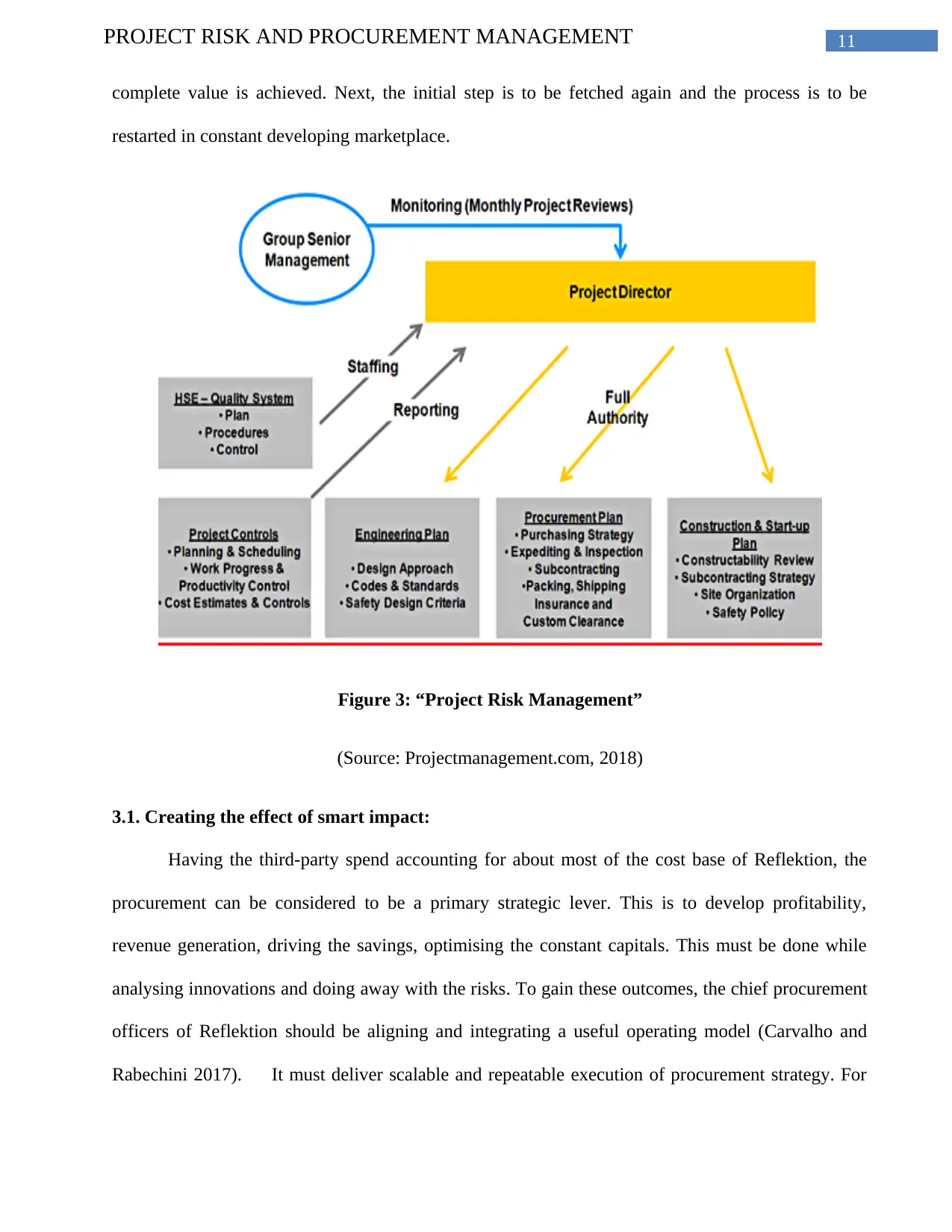
11PROJECT RISK AND PROCUREMENT MANAGEMENT
complete value is achieved. Next, the initial step is to be fetched again and the process is to be
restarted in constant developing marketplace.
Figure 3: “Project Risk Management”
(Source: Projectmanagement.com, 2018)
3.1. Creating the effect of smart impact:
Having the third-party spend accounting for about most of the cost base of Reflektion, the
procurement can be considered to be a primary strategic lever. This is to develop profitability,
revenue generation, driving the savings, optimising the constant capitals. This must be done while
analysing innovations and doing away with the risks. To gain these outcomes, the chief procurement
officers of Reflektion should be aligning and integrating a useful operating model (Carvalho and
Rabechini 2017). It must deliver scalable and repeatable execution of procurement strategy. For
complete value is achieved. Next, the initial step is to be fetched again and the process is to be
restarted in constant developing marketplace.
Figure 3: “Project Risk Management”
(Source: Projectmanagement.com, 2018)
3.1. Creating the effect of smart impact:
Having the third-party spend accounting for about most of the cost base of Reflektion, the
procurement can be considered to be a primary strategic lever. This is to develop profitability,
revenue generation, driving the savings, optimising the constant capitals. This must be done while
analysing innovations and doing away with the risks. To gain these outcomes, the chief procurement
officers of Reflektion should be aligning and integrating a useful operating model (Carvalho and
Rabechini 2017). It must deliver scalable and repeatable execution of procurement strategy. For
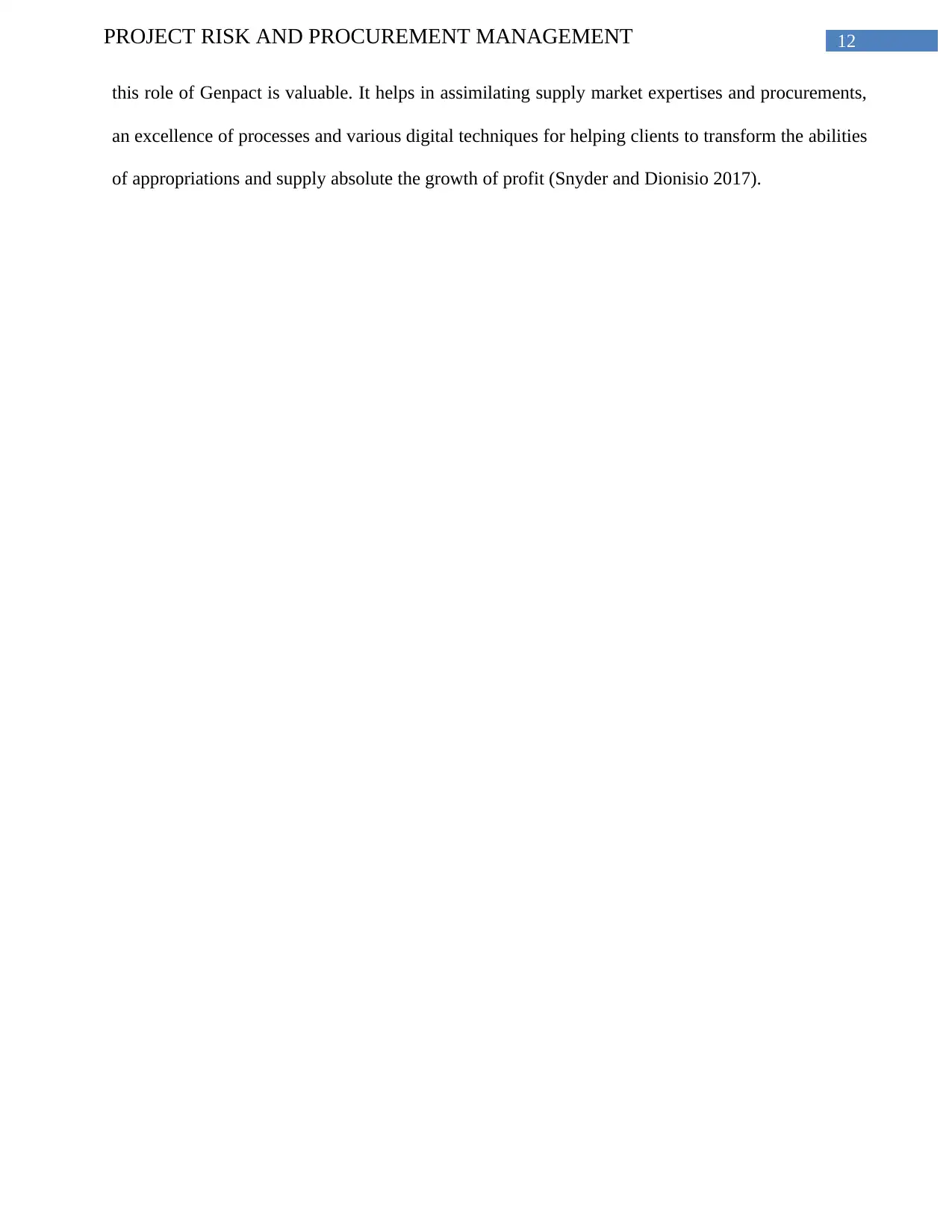
12PROJECT RISK AND PROCUREMENT MANAGEMENT
this role of Genpact is valuable. It helps in assimilating supply market expertises and procurements,
an excellence of processes and various digital techniques for helping clients to transform the abilities
of appropriations and supply absolute the growth of profit (Snyder and Dionisio 2017).
this role of Genpact is valuable. It helps in assimilating supply market expertises and procurements,
an excellence of processes and various digital techniques for helping clients to transform the abilities
of appropriations and supply absolute the growth of profit (Snyder and Dionisio 2017).
Paraphrase This Document
Need a fresh take? Get an instant paraphrase of this document with our AI Paraphraser
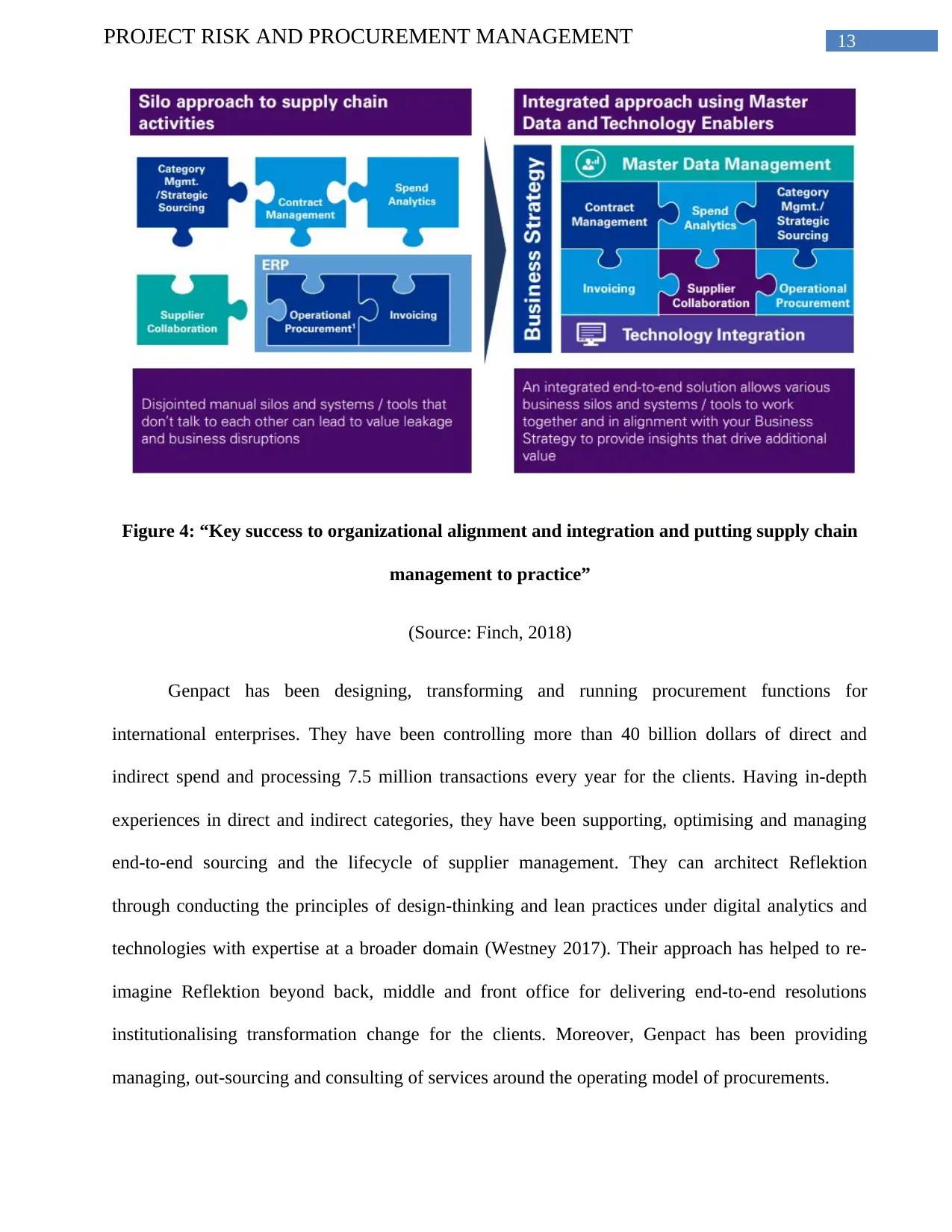
13PROJECT RISK AND PROCUREMENT MANAGEMENT
Figure 4: “Key success to organizational alignment and integration and putting supply chain
management to practice”
(Source: Finch, 2018)
Genpact has been designing, transforming and running procurement functions for
international enterprises. They have been controlling more than 40 billion dollars of direct and
indirect spend and processing 7.5 million transactions every year for the clients. Having in-depth
experiences in direct and indirect categories, they have been supporting, optimising and managing
end-to-end sourcing and the lifecycle of supplier management. They can architect Reflektion
through conducting the principles of design-thinking and lean practices under digital analytics and
technologies with expertise at a broader domain (Westney 2017). Their approach has helped to re-
imagine Reflektion beyond back, middle and front office for delivering end-to-end resolutions
institutionalising transformation change for the clients. Moreover, Genpact has been providing
managing, out-sourcing and consulting of services around the operating model of procurements.
Figure 4: “Key success to organizational alignment and integration and putting supply chain
management to practice”
(Source: Finch, 2018)
Genpact has been designing, transforming and running procurement functions for
international enterprises. They have been controlling more than 40 billion dollars of direct and
indirect spend and processing 7.5 million transactions every year for the clients. Having in-depth
experiences in direct and indirect categories, they have been supporting, optimising and managing
end-to-end sourcing and the lifecycle of supplier management. They can architect Reflektion
through conducting the principles of design-thinking and lean practices under digital analytics and
technologies with expertise at a broader domain (Westney 2017). Their approach has helped to re-
imagine Reflektion beyond back, middle and front office for delivering end-to-end resolutions
institutionalising transformation change for the clients. Moreover, Genpact has been providing
managing, out-sourcing and consulting of services around the operating model of procurements.
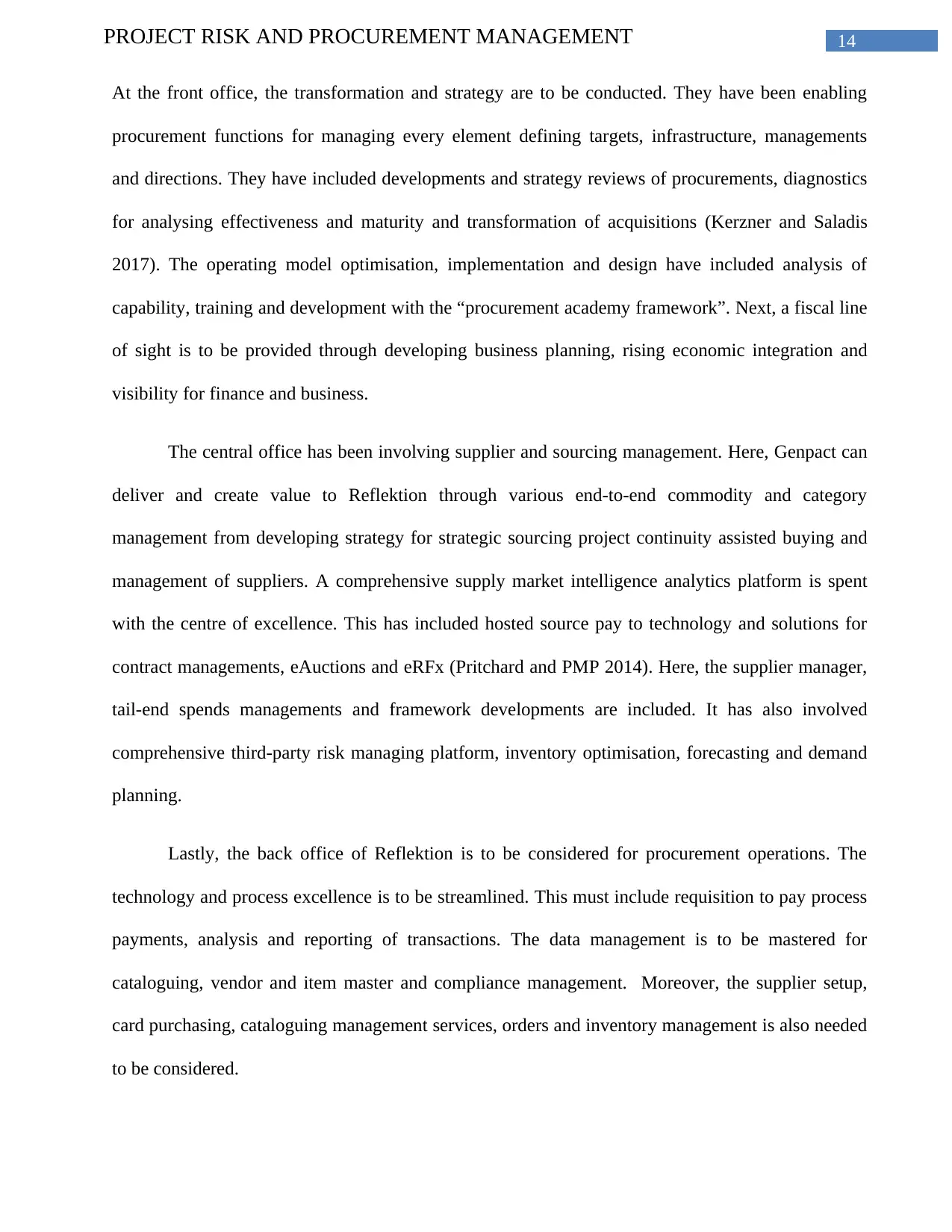
14PROJECT RISK AND PROCUREMENT MANAGEMENT
At the front office, the transformation and strategy are to be conducted. They have been enabling
procurement functions for managing every element defining targets, infrastructure, managements
and directions. They have included developments and strategy reviews of procurements, diagnostics
for analysing effectiveness and maturity and transformation of acquisitions (Kerzner and Saladis
2017). The operating model optimisation, implementation and design have included analysis of
capability, training and development with the “procurement academy framework”. Next, a fiscal line
of sight is to be provided through developing business planning, rising economic integration and
visibility for finance and business.
The central office has been involving supplier and sourcing management. Here, Genpact can
deliver and create value to Reflektion through various end-to-end commodity and category
management from developing strategy for strategic sourcing project continuity assisted buying and
management of suppliers. A comprehensive supply market intelligence analytics platform is spent
with the centre of excellence. This has included hosted source pay to technology and solutions for
contract managements, eAuctions and eRFx (Pritchard and PMP 2014). Here, the supplier manager,
tail-end spends managements and framework developments are included. It has also involved
comprehensive third-party risk managing platform, inventory optimisation, forecasting and demand
planning.
Lastly, the back office of Reflektion is to be considered for procurement operations. The
technology and process excellence is to be streamlined. This must include requisition to pay process
payments, analysis and reporting of transactions. The data management is to be mastered for
cataloguing, vendor and item master and compliance management. Moreover, the supplier setup,
card purchasing, cataloguing management services, orders and inventory management is also needed
to be considered.
At the front office, the transformation and strategy are to be conducted. They have been enabling
procurement functions for managing every element defining targets, infrastructure, managements
and directions. They have included developments and strategy reviews of procurements, diagnostics
for analysing effectiveness and maturity and transformation of acquisitions (Kerzner and Saladis
2017). The operating model optimisation, implementation and design have included analysis of
capability, training and development with the “procurement academy framework”. Next, a fiscal line
of sight is to be provided through developing business planning, rising economic integration and
visibility for finance and business.
The central office has been involving supplier and sourcing management. Here, Genpact can
deliver and create value to Reflektion through various end-to-end commodity and category
management from developing strategy for strategic sourcing project continuity assisted buying and
management of suppliers. A comprehensive supply market intelligence analytics platform is spent
with the centre of excellence. This has included hosted source pay to technology and solutions for
contract managements, eAuctions and eRFx (Pritchard and PMP 2014). Here, the supplier manager,
tail-end spends managements and framework developments are included. It has also involved
comprehensive third-party risk managing platform, inventory optimisation, forecasting and demand
planning.
Lastly, the back office of Reflektion is to be considered for procurement operations. The
technology and process excellence is to be streamlined. This must include requisition to pay process
payments, analysis and reporting of transactions. The data management is to be mastered for
cataloguing, vendor and item master and compliance management. Moreover, the supplier setup,
card purchasing, cataloguing management services, orders and inventory management is also needed
to be considered.
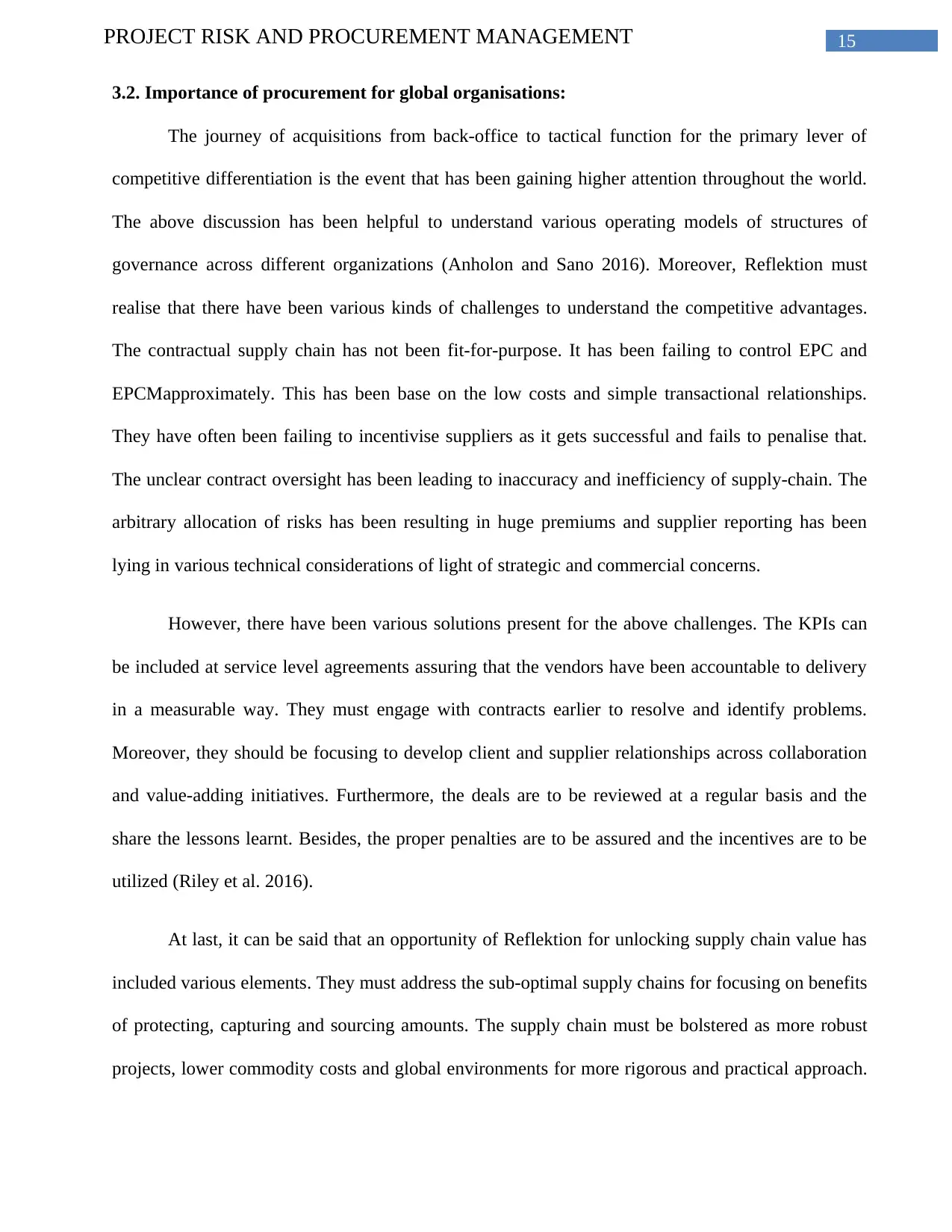
15PROJECT RISK AND PROCUREMENT MANAGEMENT
3.2. Importance of procurement for global organisations:
The journey of acquisitions from back-office to tactical function for the primary lever of
competitive differentiation is the event that has been gaining higher attention throughout the world.
The above discussion has been helpful to understand various operating models of structures of
governance across different organizations (Anholon and Sano 2016). Moreover, Reflektion must
realise that there have been various kinds of challenges to understand the competitive advantages.
The contractual supply chain has not been fit-for-purpose. It has been failing to control EPC and
EPCMapproximately. This has been base on the low costs and simple transactional relationships.
They have often been failing to incentivise suppliers as it gets successful and fails to penalise that.
The unclear contract oversight has been leading to inaccuracy and inefficiency of supply-chain. The
arbitrary allocation of risks has been resulting in huge premiums and supplier reporting has been
lying in various technical considerations of light of strategic and commercial concerns.
However, there have been various solutions present for the above challenges. The KPIs can
be included at service level agreements assuring that the vendors have been accountable to delivery
in a measurable way. They must engage with contracts earlier to resolve and identify problems.
Moreover, they should be focusing to develop client and supplier relationships across collaboration
and value-adding initiatives. Furthermore, the deals are to be reviewed at a regular basis and the
share the lessons learnt. Besides, the proper penalties are to be assured and the incentives are to be
utilized (Riley et al. 2016).
At last, it can be said that an opportunity of Reflektion for unlocking supply chain value has
included various elements. They must address the sub-optimal supply chains for focusing on benefits
of protecting, capturing and sourcing amounts. The supply chain must be bolstered as more robust
projects, lower commodity costs and global environments for more rigorous and practical approach.
3.2. Importance of procurement for global organisations:
The journey of acquisitions from back-office to tactical function for the primary lever of
competitive differentiation is the event that has been gaining higher attention throughout the world.
The above discussion has been helpful to understand various operating models of structures of
governance across different organizations (Anholon and Sano 2016). Moreover, Reflektion must
realise that there have been various kinds of challenges to understand the competitive advantages.
The contractual supply chain has not been fit-for-purpose. It has been failing to control EPC and
EPCMapproximately. This has been base on the low costs and simple transactional relationships.
They have often been failing to incentivise suppliers as it gets successful and fails to penalise that.
The unclear contract oversight has been leading to inaccuracy and inefficiency of supply-chain. The
arbitrary allocation of risks has been resulting in huge premiums and supplier reporting has been
lying in various technical considerations of light of strategic and commercial concerns.
However, there have been various solutions present for the above challenges. The KPIs can
be included at service level agreements assuring that the vendors have been accountable to delivery
in a measurable way. They must engage with contracts earlier to resolve and identify problems.
Moreover, they should be focusing to develop client and supplier relationships across collaboration
and value-adding initiatives. Furthermore, the deals are to be reviewed at a regular basis and the
share the lessons learnt. Besides, the proper penalties are to be assured and the incentives are to be
utilized (Riley et al. 2016).
At last, it can be said that an opportunity of Reflektion for unlocking supply chain value has
included various elements. They must address the sub-optimal supply chains for focusing on benefits
of protecting, capturing and sourcing amounts. The supply chain must be bolstered as more robust
projects, lower commodity costs and global environments for more rigorous and practical approach.
Secure Best Marks with AI Grader
Need help grading? Try our AI Grader for instant feedback on your assignments.
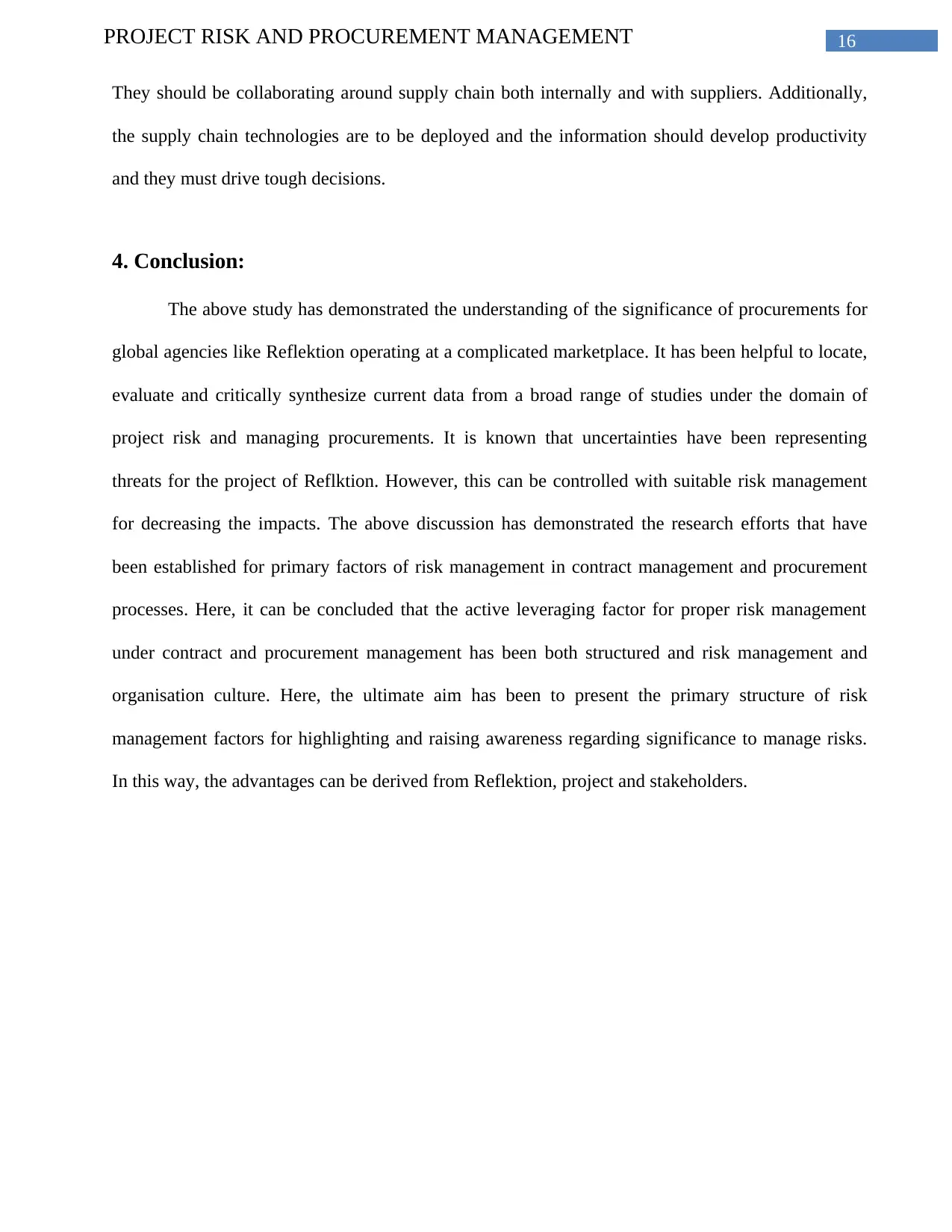
16PROJECT RISK AND PROCUREMENT MANAGEMENT
They should be collaborating around supply chain both internally and with suppliers. Additionally,
the supply chain technologies are to be deployed and the information should develop productivity
and they must drive tough decisions.
4. Conclusion:
The above study has demonstrated the understanding of the significance of procurements for
global agencies like Reflektion operating at a complicated marketplace. It has been helpful to locate,
evaluate and critically synthesize current data from a broad range of studies under the domain of
project risk and managing procurements. It is known that uncertainties have been representing
threats for the project of Reflktion. However, this can be controlled with suitable risk management
for decreasing the impacts. The above discussion has demonstrated the research efforts that have
been established for primary factors of risk management in contract management and procurement
processes. Here, it can be concluded that the active leveraging factor for proper risk management
under contract and procurement management has been both structured and risk management and
organisation culture. Here, the ultimate aim has been to present the primary structure of risk
management factors for highlighting and raising awareness regarding significance to manage risks.
In this way, the advantages can be derived from Reflektion, project and stakeholders.
They should be collaborating around supply chain both internally and with suppliers. Additionally,
the supply chain technologies are to be deployed and the information should develop productivity
and they must drive tough decisions.
4. Conclusion:
The above study has demonstrated the understanding of the significance of procurements for
global agencies like Reflektion operating at a complicated marketplace. It has been helpful to locate,
evaluate and critically synthesize current data from a broad range of studies under the domain of
project risk and managing procurements. It is known that uncertainties have been representing
threats for the project of Reflktion. However, this can be controlled with suitable risk management
for decreasing the impacts. The above discussion has demonstrated the research efforts that have
been established for primary factors of risk management in contract management and procurement
processes. Here, it can be concluded that the active leveraging factor for proper risk management
under contract and procurement management has been both structured and risk management and
organisation culture. Here, the ultimate aim has been to present the primary structure of risk
management factors for highlighting and raising awareness regarding significance to manage risks.
In this way, the advantages can be derived from Reflektion, project and stakeholders.
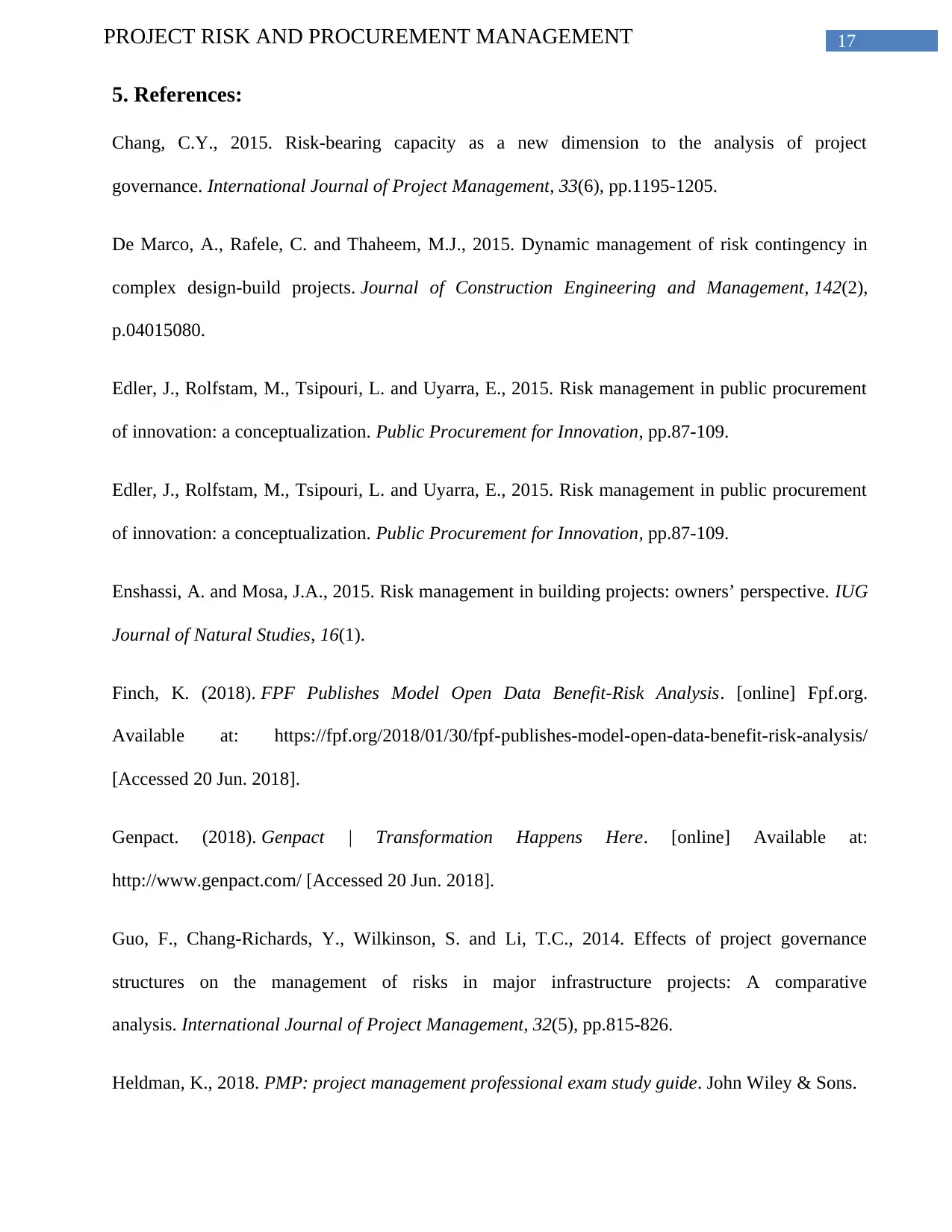
17PROJECT RISK AND PROCUREMENT MANAGEMENT
5. References:
Chang, C.Y., 2015. Risk-bearing capacity as a new dimension to the analysis of project
governance. International Journal of Project Management, 33(6), pp.1195-1205.
De Marco, A., Rafele, C. and Thaheem, M.J., 2015. Dynamic management of risk contingency in
complex design-build projects. Journal of Construction Engineering and Management, 142(2),
p.04015080.
Edler, J., Rolfstam, M., Tsipouri, L. and Uyarra, E., 2015. Risk management in public procurement
of innovation: a conceptualization. Public Procurement for Innovation, pp.87-109.
Edler, J., Rolfstam, M., Tsipouri, L. and Uyarra, E., 2015. Risk management in public procurement
of innovation: a conceptualization. Public Procurement for Innovation, pp.87-109.
Enshassi, A. and Mosa, J.A., 2015. Risk management in building projects: owners’ perspective. IUG
Journal of Natural Studies, 16(1).
Finch, K. (2018). FPF Publishes Model Open Data Benefit-Risk Analysis. [online] Fpf.org.
Available at: https://fpf.org/2018/01/30/fpf-publishes-model-open-data-benefit-risk-analysis/
[Accessed 20 Jun. 2018].
Genpact. (2018). Genpact | Transformation Happens Here. [online] Available at:
http://www.genpact.com/ [Accessed 20 Jun. 2018].
Guo, F., Chang-Richards, Y., Wilkinson, S. and Li, T.C., 2014. Effects of project governance
structures on the management of risks in major infrastructure projects: A comparative
analysis. International Journal of Project Management, 32(5), pp.815-826.
Heldman, K., 2018. PMP: project management professional exam study guide. John Wiley & Sons.
5. References:
Chang, C.Y., 2015. Risk-bearing capacity as a new dimension to the analysis of project
governance. International Journal of Project Management, 33(6), pp.1195-1205.
De Marco, A., Rafele, C. and Thaheem, M.J., 2015. Dynamic management of risk contingency in
complex design-build projects. Journal of Construction Engineering and Management, 142(2),
p.04015080.
Edler, J., Rolfstam, M., Tsipouri, L. and Uyarra, E., 2015. Risk management in public procurement
of innovation: a conceptualization. Public Procurement for Innovation, pp.87-109.
Edler, J., Rolfstam, M., Tsipouri, L. and Uyarra, E., 2015. Risk management in public procurement
of innovation: a conceptualization. Public Procurement for Innovation, pp.87-109.
Enshassi, A. and Mosa, J.A., 2015. Risk management in building projects: owners’ perspective. IUG
Journal of Natural Studies, 16(1).
Finch, K. (2018). FPF Publishes Model Open Data Benefit-Risk Analysis. [online] Fpf.org.
Available at: https://fpf.org/2018/01/30/fpf-publishes-model-open-data-benefit-risk-analysis/
[Accessed 20 Jun. 2018].
Genpact. (2018). Genpact | Transformation Happens Here. [online] Available at:
http://www.genpact.com/ [Accessed 20 Jun. 2018].
Guo, F., Chang-Richards, Y., Wilkinson, S. and Li, T.C., 2014. Effects of project governance
structures on the management of risks in major infrastructure projects: A comparative
analysis. International Journal of Project Management, 32(5), pp.815-826.
Heldman, K., 2018. PMP: project management professional exam study guide. John Wiley & Sons.
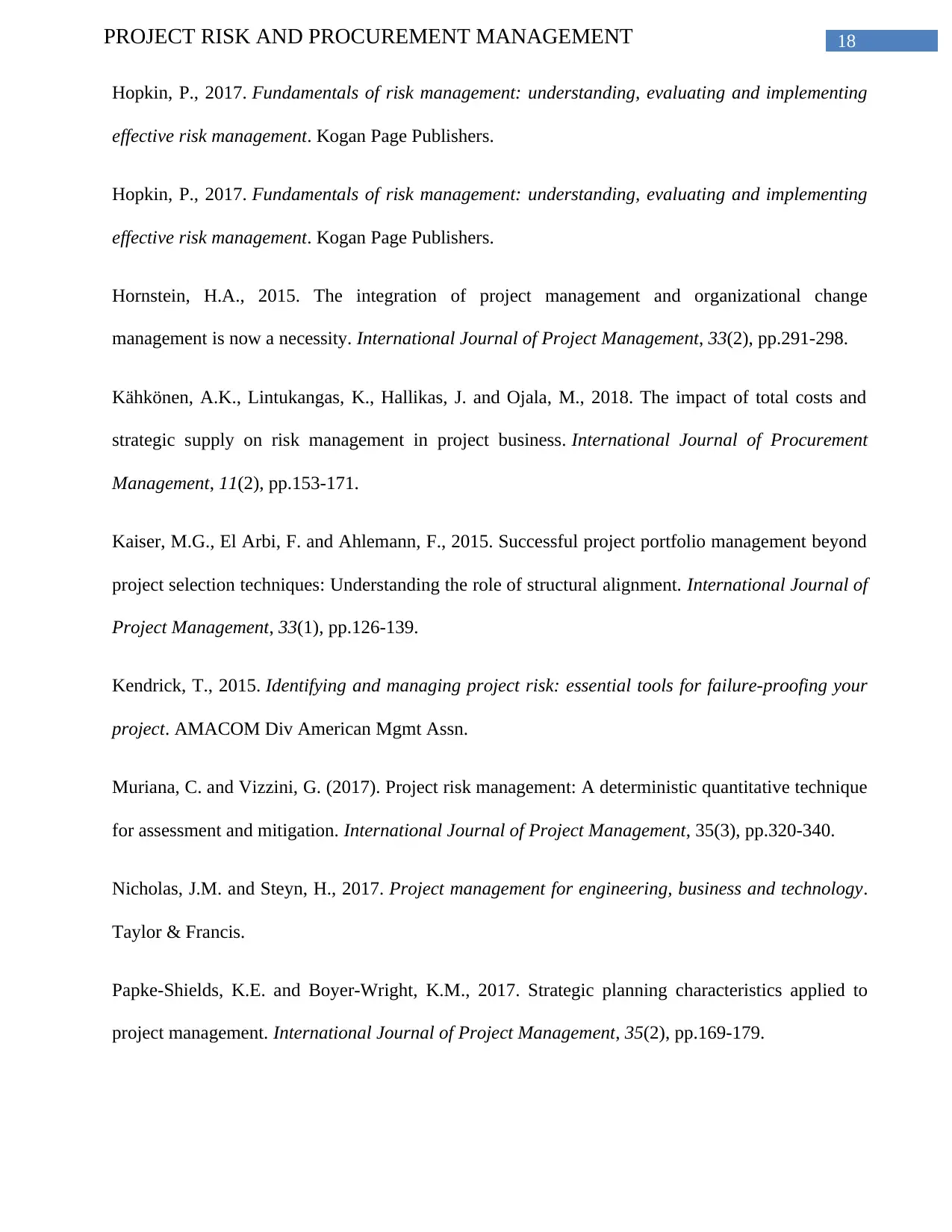
18PROJECT RISK AND PROCUREMENT MANAGEMENT
Hopkin, P., 2017. Fundamentals of risk management: understanding, evaluating and implementing
effective risk management. Kogan Page Publishers.
Hopkin, P., 2017. Fundamentals of risk management: understanding, evaluating and implementing
effective risk management. Kogan Page Publishers.
Hornstein, H.A., 2015. The integration of project management and organizational change
management is now a necessity. International Journal of Project Management, 33(2), pp.291-298.
Kähkönen, A.K., Lintukangas, K., Hallikas, J. and Ojala, M., 2018. The impact of total costs and
strategic supply on risk management in project business. International Journal of Procurement
Management, 11(2), pp.153-171.
Kaiser, M.G., El Arbi, F. and Ahlemann, F., 2015. Successful project portfolio management beyond
project selection techniques: Understanding the role of structural alignment. International Journal of
Project Management, 33(1), pp.126-139.
Kendrick, T., 2015. Identifying and managing project risk: essential tools for failure-proofing your
project. AMACOM Div American Mgmt Assn.
Muriana, C. and Vizzini, G. (2017). Project risk management: A deterministic quantitative technique
for assessment and mitigation. International Journal of Project Management, 35(3), pp.320-340.
Nicholas, J.M. and Steyn, H., 2017. Project management for engineering, business and technology.
Taylor & Francis.
Papke-Shields, K.E. and Boyer-Wright, K.M., 2017. Strategic planning characteristics applied to
project management. International Journal of Project Management, 35(2), pp.169-179.
Hopkin, P., 2017. Fundamentals of risk management: understanding, evaluating and implementing
effective risk management. Kogan Page Publishers.
Hopkin, P., 2017. Fundamentals of risk management: understanding, evaluating and implementing
effective risk management. Kogan Page Publishers.
Hornstein, H.A., 2015. The integration of project management and organizational change
management is now a necessity. International Journal of Project Management, 33(2), pp.291-298.
Kähkönen, A.K., Lintukangas, K., Hallikas, J. and Ojala, M., 2018. The impact of total costs and
strategic supply on risk management in project business. International Journal of Procurement
Management, 11(2), pp.153-171.
Kaiser, M.G., El Arbi, F. and Ahlemann, F., 2015. Successful project portfolio management beyond
project selection techniques: Understanding the role of structural alignment. International Journal of
Project Management, 33(1), pp.126-139.
Kendrick, T., 2015. Identifying and managing project risk: essential tools for failure-proofing your
project. AMACOM Div American Mgmt Assn.
Muriana, C. and Vizzini, G. (2017). Project risk management: A deterministic quantitative technique
for assessment and mitigation. International Journal of Project Management, 35(3), pp.320-340.
Nicholas, J.M. and Steyn, H., 2017. Project management for engineering, business and technology.
Taylor & Francis.
Papke-Shields, K.E. and Boyer-Wright, K.M., 2017. Strategic planning characteristics applied to
project management. International Journal of Project Management, 35(2), pp.169-179.
Paraphrase This Document
Need a fresh take? Get an instant paraphrase of this document with our AI Paraphraser
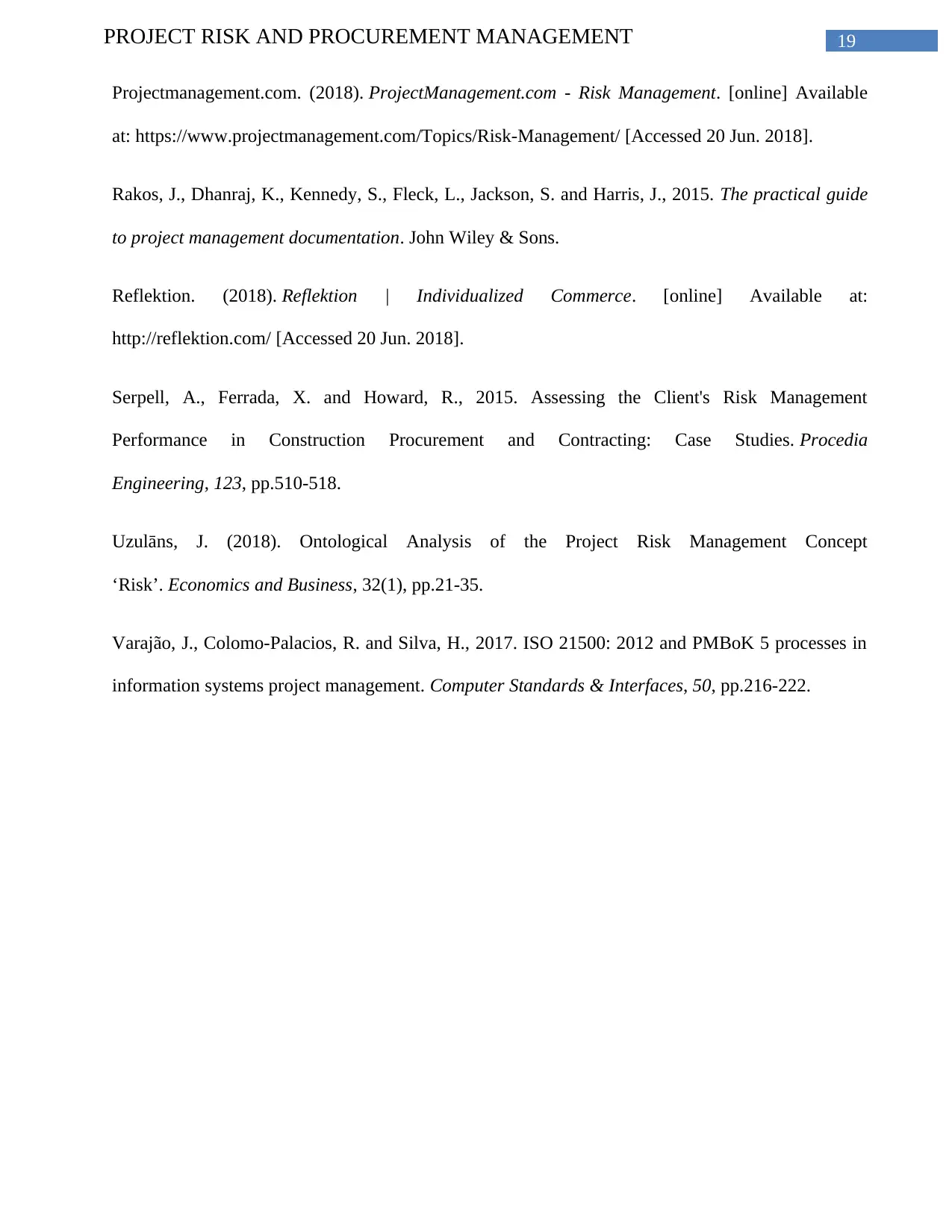
19PROJECT RISK AND PROCUREMENT MANAGEMENT
Projectmanagement.com. (2018). ProjectManagement.com - Risk Management. [online] Available
at: https://www.projectmanagement.com/Topics/Risk-Management/ [Accessed 20 Jun. 2018].
Rakos, J., Dhanraj, K., Kennedy, S., Fleck, L., Jackson, S. and Harris, J., 2015. The practical guide
to project management documentation. John Wiley & Sons.
Reflektion. (2018). Reflektion | Individualized Commerce. [online] Available at:
http://reflektion.com/ [Accessed 20 Jun. 2018].
Serpell, A., Ferrada, X. and Howard, R., 2015. Assessing the Client's Risk Management
Performance in Construction Procurement and Contracting: Case Studies. Procedia
Engineering, 123, pp.510-518.
Uzulāns, J. (2018). Ontological Analysis of the Project Risk Management Concept
‘Risk’. Economics and Business, 32(1), pp.21-35.
Varajão, J., Colomo-Palacios, R. and Silva, H., 2017. ISO 21500: 2012 and PMBoK 5 processes in
information systems project management. Computer Standards & Interfaces, 50, pp.216-222.
Projectmanagement.com. (2018). ProjectManagement.com - Risk Management. [online] Available
at: https://www.projectmanagement.com/Topics/Risk-Management/ [Accessed 20 Jun. 2018].
Rakos, J., Dhanraj, K., Kennedy, S., Fleck, L., Jackson, S. and Harris, J., 2015. The practical guide
to project management documentation. John Wiley & Sons.
Reflektion. (2018). Reflektion | Individualized Commerce. [online] Available at:
http://reflektion.com/ [Accessed 20 Jun. 2018].
Serpell, A., Ferrada, X. and Howard, R., 2015. Assessing the Client's Risk Management
Performance in Construction Procurement and Contracting: Case Studies. Procedia
Engineering, 123, pp.510-518.
Uzulāns, J. (2018). Ontological Analysis of the Project Risk Management Concept
‘Risk’. Economics and Business, 32(1), pp.21-35.
Varajão, J., Colomo-Palacios, R. and Silva, H., 2017. ISO 21500: 2012 and PMBoK 5 processes in
information systems project management. Computer Standards & Interfaces, 50, pp.216-222.
1 out of 20
Related Documents
Your All-in-One AI-Powered Toolkit for Academic Success.
+13062052269
info@desklib.com
Available 24*7 on WhatsApp / Email
![[object Object]](/_next/static/media/star-bottom.7253800d.svg)
Unlock your academic potential
© 2024 | Zucol Services PVT LTD | All rights reserved.




